
From its earliest inceptions, science fiction has blurred the line between reality and technological fantasy in a remarkably prescient manner. Many of the discoveries and gadgets that have integrated seamlessly into modern life were first preconceived theoretically. More recently, the technologies behind ultra-realistic visual and motion capture effects are simultaneously helping scientists as research tools on a granular level in real time. The dazzling visual effects within the time-jumping space film Interstellar included creating original code for a physics-based ultra-realistic depiction of what it would be like to orbit around and through a black hole. Astrophysics researchers soon utilized the film’s code to visualize black hole surfaces and their effects on nearby objects. Virtual reality, whose initial development was largely rooted in imbuing realism into the gaming and video industries, has advanced towards multi-purpose applications in film, technology and science. The Science Channel is augmenting traditional programming with a ‘virtual experience’ to simulate the challenges and scenarios of an astronaut’s journey into space; VR-equipped GoPro cameras are documenting remote research environments to foster scientific collaboration and share knowledge; it’s even being implemented in health care for improving training, diagnosis and treatment concepts. The ability to record high-definition film of landscapes and isolated areas with drones, which will have an enormous impact on cinematography, carries with it the simultaneous capacity to aid scientists and health workers with disaster relief, wildlife conservation and remote geomapping.
The evolution of entertainment industry technology is sophisticated, computationally powerful and increasingly cross-functional. A cohort of interdisciplinary researchers at Northwestern University is adapting computing and screen resolution developed at DreamWorks Animation Studios as a vehicle for data visualization, innovation and producing more rapid and efficient results. Their efforts, detailed below, and a collective trend towards integration of visual design in interpreting complex research, portends a collaborative future between science and entertainment.
Not long into his tenure as the lead visualization engineer at Northwestern University’s Center For Advanced Molecular Imaging (CAMI), Matt McCrory noticed a striking contrast between the quality of the aesthetic and computational toolkits used in scientific research versus the entertainment industry. “When you spend enough time in the research community, with people who are doing the research and the visualization of their own data, you start to see what an immense gap there is between what Hollywood produces (in terms of visualization) and what research produces.” McCrory, a former lighting technical director at DreamWorks Animation, where he developed technical tools for the visual effects in Shark Tale, Flushed Away and Kung Fu Panda, believes that combining expertise in cutting-edge visual design with emerging tools of molecular medicine, biochemistry and pharmacology can greatly speed up the process of discovery. Initially, it was science that offered the TV and film world the rudimentary seeds of technology that would fuel creative output. But the TV and film world ran with it — so much so, that the line between science and art is less distinguishable than in any other industry. “We’re getting to a point [on the screen] where we can’t discern anymore what’s real and what’s not,” McCrory notes. “That’s how good Hollywood [technology] is getting. At the same time, you see very little progress being made in scientific visualization.”
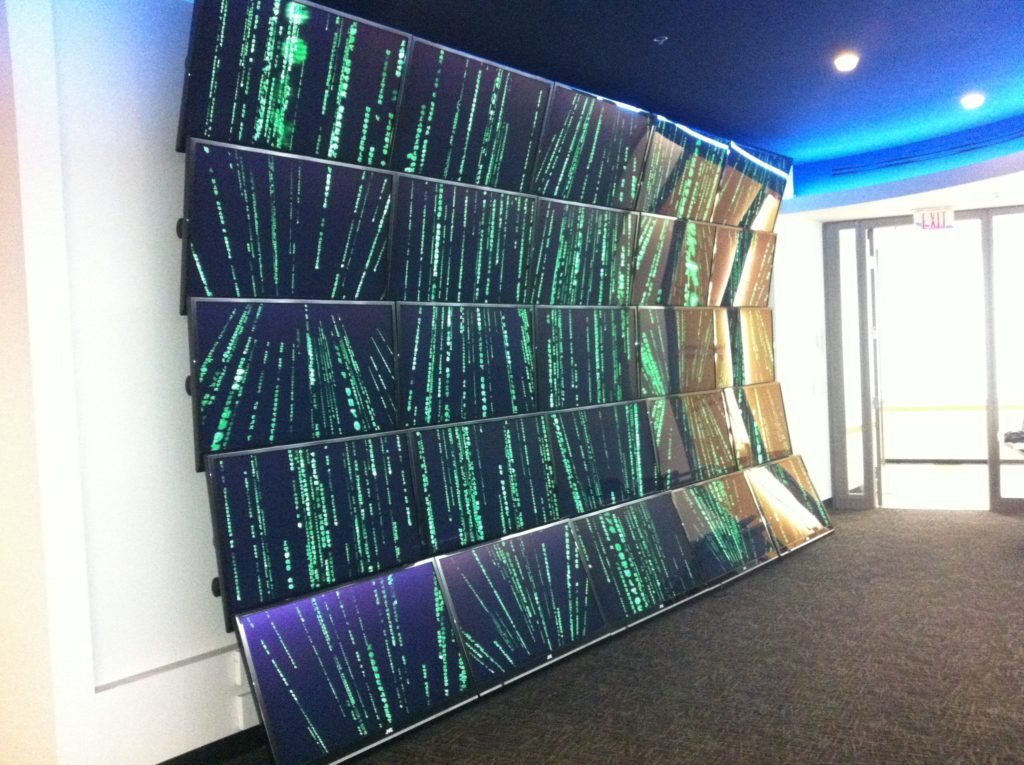
What is most perplexing about the stagnant computing power and visualization in science is that modern research across almost all fields is driven by extremely large, high-resolution data sets. A handful of select MRI imaging scanners are now equipped with magnets ranging from 9.4 to 11.75 Teslas, capable of providing cellular resolution on the micron scale (0.1 to 0.2 millimeters versus 1.5 Tesla hospital scanners, at 1 millimeter resolution) and cellular changes on the microsecond scale. The ultra high-resolution imaging provides researchers with insight into everything from cancer to neurodegenerative diseases. While most biomedical drug discovery today is engineered by robotics equipment, which screens enormous libraries of chemical compounds for activity potential around the clock in a “high-throughput” fashion — from thousands to hundreds of thousands of samples — data must still be analyzed, optimized and implemented by researchers. Astronomical observations (from black holes to galaxies colliding to detailed high-power telescope observations in the billions of pixels) produce some of the largest data sets in all of science. Molecular biology and genetics, which in the genomics era has unveiled great potential for DNA-based sub-cellular therapeutics, has also produced petrabytes of data sets that are a quandary for most researchers to store, let alone visualize.
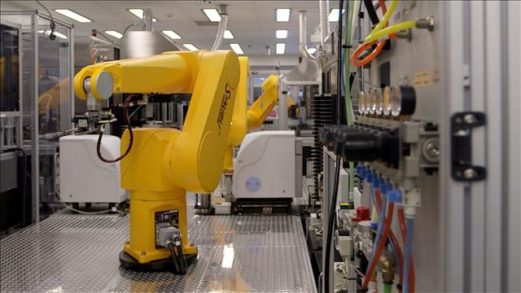
Unfortunately, most scientists can’t allocate dual resources to both advancing their own research and finding the best technology with which to optimize it. As McCrory points out: “In a field like chemistry or biology, you don’t have people who are working day and night with the next greatest way of rendering photo-realistic images. They’re focused on something related to protein structures or whatever their research is.”

The entertainment industry, on the other hand, has a singular focus on developing and continuously perfecting these tools, as necessitated by proliferation of divergent content sources, screen resolution and powerful capture devices. As an industry insider, McCrory appreciates the competitive evolution, driven by an urgency that science doesn’t often have to grapple with. “They’ve had to solve some serious problems out there and they also have to deal with issues involving timelines, since it’s a profit-driven industry,” he notes. “So they have to come up with [computing] solutions that are purely about efficiency.” Disney’s 2014 animated science film Big Hero 6 was rendered with cutting-edge visualization tools, including a 55,000-core computer and custom proprietary lighting software called Hyperion. Indeed, render farms at LucasFilm and Pixar consist of core data centers and state-of-the-art supercomputing resources that could be independent enterprise server banks.
At Northwestern’s CAMI, this aggregate toolkit is leveraged by scientists and visual engineers as an integrated collaborative research asset. In conjunction with a senior animation specialist and long-time video game developer, McCrory helped to construct an interactive 3D visualization wall consisting of 25 high-resolution screens that comprise 52 million total pixels. Compared to a standard computer (at 1-2 million pixels), the wall allows researchers to visualize and manage entire data sets acquired with higher-quality instruments. Researchers can gain different perspectives on their data in native resolution, often standing in front of it in large groups, and analyze complex structures (such as proteins and DNA) in 3D. The interface facilitates real-time innovation and stunning clarity for complex multi-disciplinary experiments. Biochemists, for example, can partner with neuroscientists to visualize brain activity in a mouse as they perfect drug design for an Alzheimer’s enzyme inhibitor. Additionally, 7 thousand in-house high performing core servers (comparable to most studios) provide undisrupted big data acquisition, storage and mining.
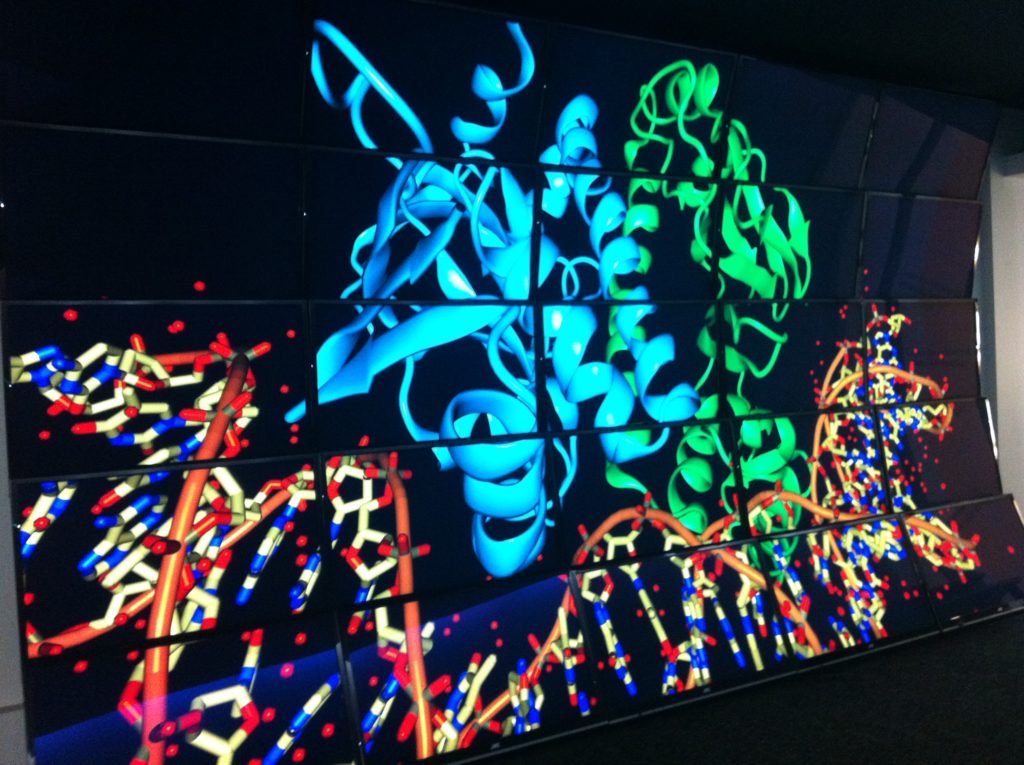
Could there be a day where partnerships between science and entertainment are commonplace? Virtual reality studios such as Wevr, producing cutting-edge content and wearable technology, could become a go-to virtual modeling destination for physicists and structural chemists. Programs like RenderMan, a photo-realistic 3D software developed by Pixar Animation Studios for image synthesis, could enable greater clarity on biological processes and therapeutics targets. Leading global animation studios could be a source of both render farm technology and talent for science centers to increase proficiency in data analysis. One day, as its own visualization capacity grows, McCrory, now pushing pixels at animation studio Rainmaker Entertainment, posits that NUViz/CAMI could even be a mini-studio within Chicago for aspiring filmmakers.
The entertainment industry has always been at the forefront of inspiring us to “dream big” about what is scientifically possible. But now, it can play an active role in making these possibilities a reality.
*****************
ScriptPhD.com covers science and technology in entertainment, media and advertising. Hire our consulting company for creative content development. Follow us on Twitter and Facebook. Subscribe to our podcast on SoundCloud or iTunes.

The current scientific landscape can best be thought of as a transitional one. With the proliferation of scientific innovation and the role that technology plays in our lives, along with the demand for more of these breakthroughs, comes the simultaneous challenge of balancing affordable lab space, funding and opportunity for young investigators and inventors to shape their companies and test novel projects. Los Angeles science incubator Lab Launch is trying to simplify the process through a revolutionary, not-for-profit approach that serves as a proof of concept for an eventual interconnected network of “discovery hubs”. Founder Llewelyn Cox sits down with ScriptPhD for an insightful podcast that assesses the current scientific climate, the backdrop that catalyzed Lab Launch, and why alternatives to traditional avenues of research are critical for fueling the 21st Century economy.
As science and biotechnology innovation go, we are, to put it in Dickensian terms, in the best of times and the worst of times.
On the one hand, we are in the midst of a pioneering golden age of discovery, biomedical cures and technological evolution. It seems that every day brings limitless possibility and unbridled imagination. Recent development of CRISPR gene-editing machinery will facilitate specific genome splicing and wholescale epigenetic insight into disease and function. Immunotherapy, programming the body’s innate immune system and utilizing it to eradicate targeted tumors, represents the biggest progress in cancer research in decades. For the first time ever, physicists have detected and quantified gravitational waves, underscoring Einsteins theory of gravity, relativity and how the space continuum expands and contracts. The private company SpaceX landed a rocket on a drone ship for the first time, enabling faster, cheaper launches and reusable rockets.

Despite these exciting and hopeful advancements, many of which have the potential to greatly benefit society and quality of life, there remain tangible challenges to fostering and preserving innovation. Academic science produces too many PhDs, which saturates the job market, stifles viable prospects for the most talented scientists and even hurts science in the long run. Exacerbating this problem is a shortage of basic research funding in the United States that represents the worst crisis in 50 years. And while European countries experience a similar pullback in grant availability, developing countries are investing in research as an avenue of future economic growth. High-risk, high-reward research, particularly from young investigators, is suppressed at the expense of “safe research” and already-wealthy, established labs. Conduits towards entrepreneurship are possible, many through commercializing academic findings, but few come without strings attached, start-up companies are in a 48% decline since the 1970s. With research and development stagnating at most big pharmaceutical companies and current biomedical research growth unsustainable, there is an unprecedented opportunity to disrupt the innovation pipeline and create a more robust economy.
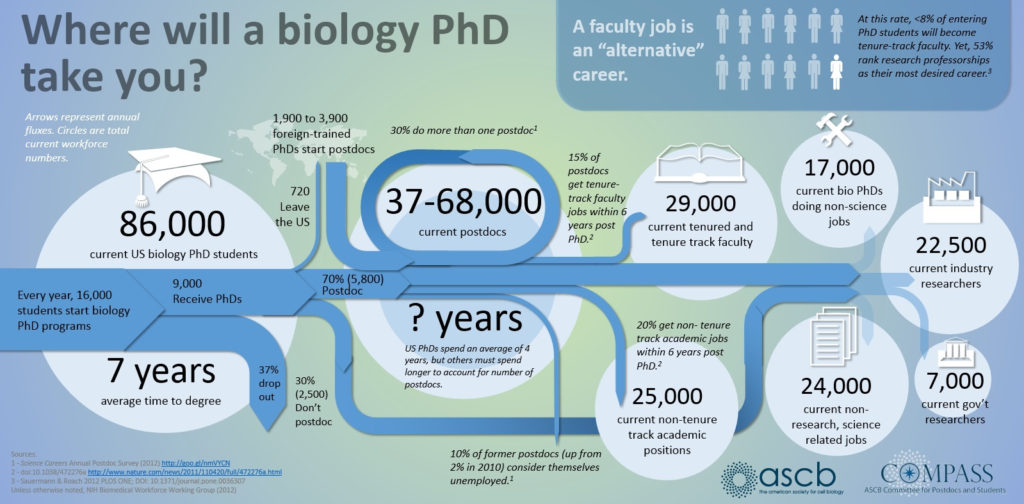
In an effort to boost discovery and development, there has been a permeation of venture capital accelerators and think-tank style early stage incubators from the technology sector into basic science; indeed it’s experiencing a proliferating boom. Affordable space, world-class facilities, access to startup capital and a opportunity to explore high-risk ideas — all are attractive to young academics and scientific entrepreneurs. Even pharmaceutical giants are spawning innovation arms as potential sources of future ideas. Large cities like New York are even using incubator space as a catalyst for growing a localized biotechnology-fueled economy. Such opportunities, however, don’t come without risk and collateral to innovators. As Mike Jones of science, inc. warns, the single biggest question that innovators must asses is: “Is the value I am getting equal to the risk I am saving, through equity?” Many incubators and accelerators act as direct conduits to academia and industry, both for talent recruitment and retention of intellectual material. In fact, the business model governing incubator space and asset allocation can often be nebulous, and sometimes further complicated by mandatory “collaborative” sharing not just of materials and space, but data and intellectual property. Even wealthy investors, who are now underwriting academic and private sector research, want a voice in the type of research and how it is conducted.
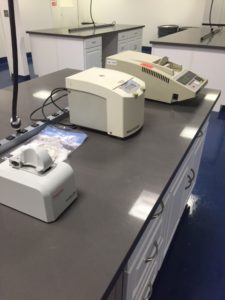
Amidst this idea-driven revolution was borne the concept of Lab Launch, a transformative permutation of incubator space for fostering pharmaceutical and biotechnology innovation. The fundamental principle behind Los Angeles-based Lab Launch is deceptively simple. As a not-for-profit endeavor, it provides simple, sleek and high-level equipment and space for life science and biotechnology experimentation. Because all shared equipment is donated as overflow from companies and laboratories that no longer need it, costs are minimized towards laboratory management fees and rental of facilities. As a stripped-down discovery engine model, this allows Lab Launch scientists to keep 100% of their intellectual property and equity, something that is virtually unheralded for young innovators at early-development stages. On a more complex level, the potential wide-scale benefits of Lab Launch (and future copycat spawns) are profound and resonant. In an industry where the Boston-San Francisco-San Diego triumvirate presents a near-hegemony for biotechnology funding, development and intellectual assets, the growth of simple, inexpensive science incubators in large cities carries tremendous economic upside. Critics might point out the lack of substantive guidance and elite think tank access of such a platform, yet 90% of all incubators and accelerators still fail, regardless. Moreover, selection criteria are often biased towards specific business interests or research aims that buoy academia and venture capital profiteers, which weed out the most high-risk ideas and participants. How, for example, would a scientist without a PhD or prestigious pedigree get access to a mainstream incubator lab space? How would a radically non-traditional idea or approach merit mainstream support or funding? A recent Harvard Business Review article suggests that lean start-ups with the most efficient, bare-bones development models, have far higher success rates and should be the template for driving an innovation-based economy. As elucidated in the podcast below, opening doors to facilitate proof-of-concept innovation and linking a virtual network of lab spaces will give rise to not just the next Silicon Valley, but the great scientific breakthroughs of tomorrow.
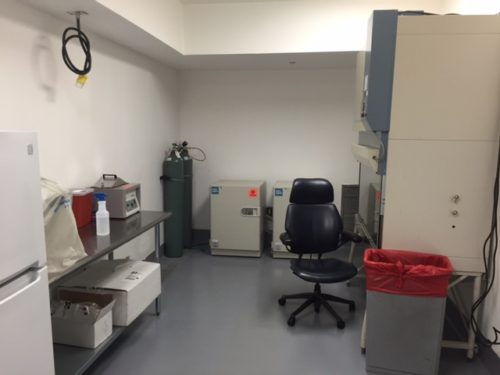
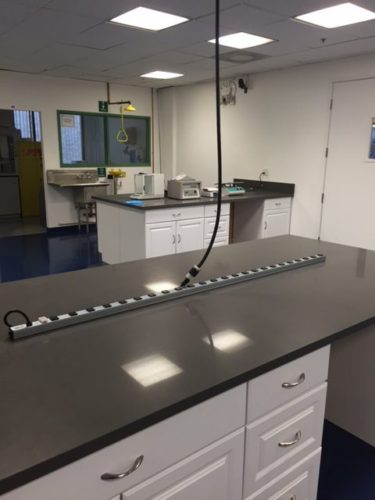
Lab Launch founder Dr. Llewellyn Cox sat down with ScriptPhD for a podcast interview to talk about his revolutionary not-for-profit startup incubator and the challenging scientific environment that inspired the idea. Among our topics of discussion:
•How lack of funding and overflow of PhDs in the current scientific climate stifles creativity and innovation
•Why biotechnology will cultivate exciting new industries in the 21st Century
•How no strings attached incubators like Lab Launch help give rise to Silicon Valleys of the future
•Why we should in fact be hopeful about how scientific progress is advancing
*****************
ScriptPhD.com covers science and technology in entertainment, media and advertising. Hire our consulting company for creative content development. Follow us on Twitter and Facebook. Subscribe to our podcast on SoundCloud or iTunes.
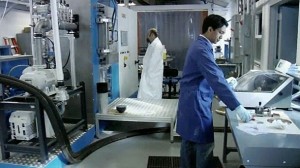
The last 25 years have brought an unprecedented level of scientific and technological advances, impacting virtually all dimensions of society, from communication and the digital revolution, to economics and food production to nanotechnology and medicine – and that’s just a start. The next few decades will rapidly expand this progress with exponential discovery and innovation, amidst more pressing global challenges than we’ve ever faced before. The opportunities to develop faster, better and cheaper products that improve modern living are limitless – Tesla electric cars, energy-saving fuels and machines, robotics – but they all share a common basic need for developing and studying materials in a more efficient manner. This will require a real-time acceleration of sharing, analytics and simulation through readily accessible databases. Essentially, an open-source wiki for materials scientists. In our in-depth article below, ScriptPhD.com explains why materials science is the most critical gateway towards 21st Century technology and how California startup company Citrine Informatics is providing revolutionary new information extraction software to create a crowdsourced, open access database available to any scientist.
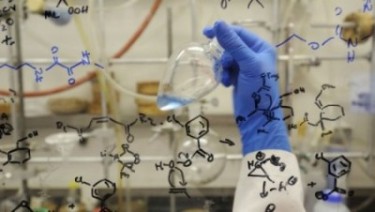
There has been a public access revolution of sorts transforming science. A necessary one, at that. Science funding is in crisis. The peer-review process is under heavy scrutiny. And scientists are turning to transparency to help. Some notable billionaires are circumventing public funding and privatizing science. Molecular biologist Ethan Perlstein has used crowdfunding to raise hundreds of thousands of dollars from the public at large for a basic research lab. Last fall, as the Ebola crisis gripped the world’s attention, an expert researcher at The Scripps Research Institute (where I received a PhD) appealed to public crowd funding to raise $100,000 for vaccine research. With platforms like Experiment, RocketHub and KickStarter proliferating support for science, the public at large has begun to serve as an important incubator of innovation. More importantly, researchers are increasingly rethinking traditional academic publishing and recognizing the value of open data sharing through publications and databases. The Public Library of Science (PLoS) is the biggest non-profit advocate and publisher of open access research. Mainstream journals like Science have begun publishing free web-based alternatives that are immediately accessible. Calls for unified data sharing have grown louder and more widespread. Even the FDA has announced plans for crowdsourcing a genomics research platform to improve efficiency of diagnostic and clinical tests and their analysis. Far from hindering the scientific process and output, these efforts have accelerated alternative means of funding, data acquisition and exchange, collaboration and ultimately, discovery.
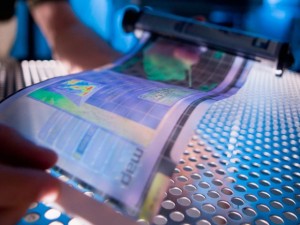
Think about virtually any practical aspect of life and it relies on materials. Transportation of any kind, Kevlar vests, sports equipment, communication devices, clothing, growing and making food… it’s impossible to think about modern society in even the most impoverished developing countries without them. Now think on a bigger scale. Superconductors. Carbon nanotubules. Graphene. The materials of the future that make even these breakthroughs obsolete. So crucial is materials science to all facets of economics, research and quality of life, that in 2011, the United States Government launched a Materials Genome Initiative. A partnership between the private sector industry, universities, and the government, its primary goal is to utilize a materials genome approach to cut the cost and time to market for basic materials products by 50%.

The only problem with materials research? Data. And lots of it. Aided largely by digital services and a proliferation of technology research – not to mention marketplace for the products that it makes possible – there is so much data produced today that the process of testing, developing, tweaking and inserting a material into a product takes about 20 years, according to the National Academy of Sciences. To combat this, materials scientists and engineers have growingly embraced a similar open access philosophy to that of life scientists. Leading science publisher Elsevier recently launched an infrastructure called “Open Data” to facilitate materials science data sharing across thirteen major publications. The Lawrence Berkeley National Laboratory just created the world’s largest database of elastic properties, a virtual gold mine for scientists working on materials that require mechanical properties for things like cars and airplanes. NASA has even opened a Physical Science Informatics database of all of its space station materials research in the hopes that the crowdsourcing accelerates engineering research discovery, applicable both to space and Earth.
Citrine Informatics, a startup company in California, is hoping to unify these concepts of data sharing and mining through open access web-based software (boosted by crowdsourcing) to build a comprehensive, open database of materials and chemical data. Essentially, Citrine is rolling out a cloud platform (Citrination) that will act as a digital middle man between data acquisition and product development. And rather than storing it in vastly differing locations under differing access guidelines, Citrination’s algorithms gather all available data (from publications to databases to publicly shared data from private companies) in order to show properties under different conditions, including when they might fail. A simple, mainframe registry database allows users to upload data, build customized data sets and see all known properties of a particular material under all different physical conditions (see below). Rater than testing and retesting internal materials data internally, thus lengthening R&D pipelines, research labs can simply model based on available information and adjust experiments accordingly.
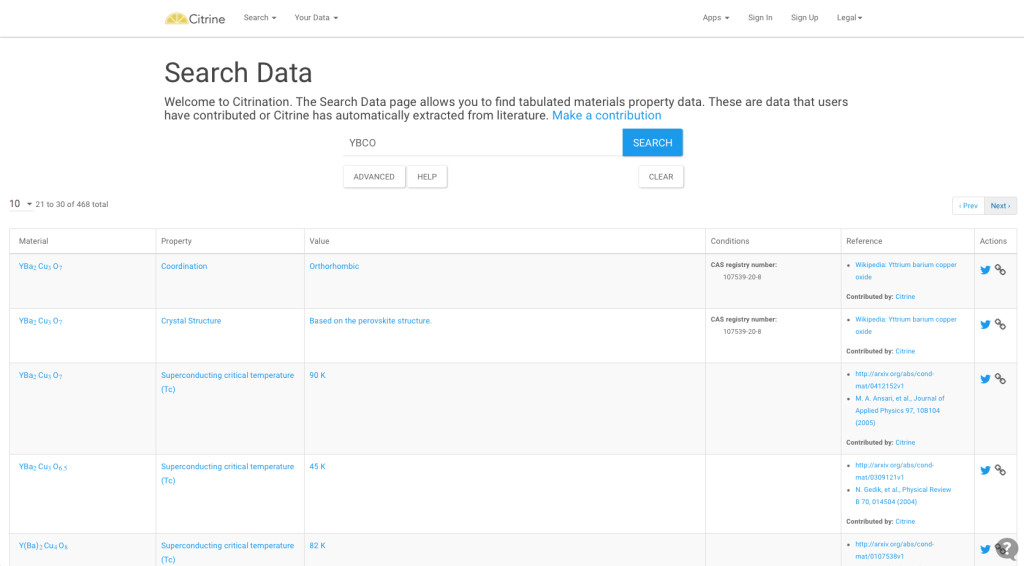
“What we do represents a big change in the status quo,” co-founder Bryce Meredig says. “A lot of the scientists in these industries don’t have a natural inclination to turn to software to solve these problems.” Until now. The software will be made free to not for profit research institutions and will sell to materials and chemical companies that want to avail themselves of the wealth of data. Citrine has used a large recent infusion of grant funding to raise their ambition beyond a database and towards applications like 3D printing, renewable energy technology (co-founder Greg Mulholland was recognized by Forbes as a 30 under 30 leader in energy) and the next generation of devices.
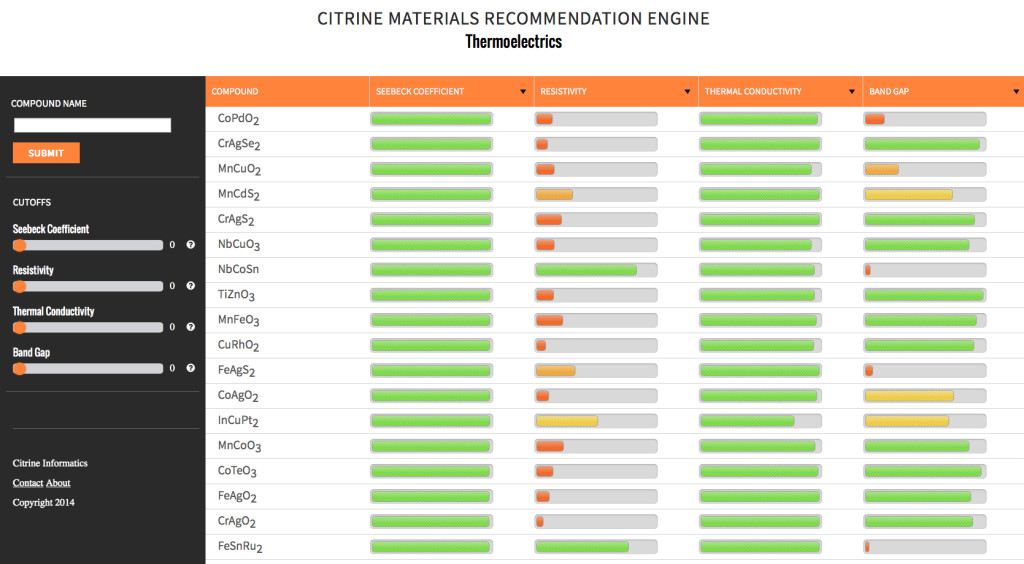
The practical benefits to society as a whole of extending open access and crowdsourcing to materials science are tremendous. On an individual level, virtually every computer and mobile device we put in our hands, every gadget and machine we buy in the future will depend on improved materials. On a more wide-scale level, materials will be at the forefront of solving the most complex, important challenges to our planet and its inhabitants, none more important than the energy crisis. Food production, water purification and distribution, transportation, infrastructure all will rely on creating sustainable energy. More ambitious endeavors such as space travel, medical treatments and advanced research collaborations will be even more reliant on new and improved materials. The faster that scientists, researchers and engineers are able to mine data from previous experiments, replicate it and design smarter studies based on computerized algorithms of how those materials behave, the faster they can produce breakthroughs in the laboratory and into the marketplace. The stakes are high. The scientific rewards are infinite. The time to open and use a free-access materials database is now.
This article was sponsored by Citrine Informatics.
*****************
ScriptPhD.com covers science and technology in entertainment, media and advertising. Hire our consulting company for creative content development. Follow us on Twitter and Facebook. Subscribe to our podcast on SoundCloud or iTunes.
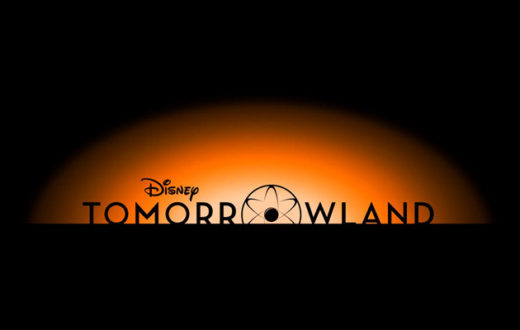
One of Walt Disney’s enduring lifetime legacies was his commitment to innovation, new ideas and imagination. An inventive visionary, Disney often previewed his inventions at the annual New York World’s Fair and contributed many technological and creative breakthroughs that we enjoy to this day. One of Disney’s biggest fascinations was with space exploration and futurism, often reflected thematically in Disney’s canon of material throughout the years. Just prior to his death in 1966, Disney undertook an ambitious plan to build a utopian “Community of Tomorrow,” complete with state-of-the-art technology. Indeed, every major Disney theme park around the world has some permutation of a themed section called “Tomorrowland,” first introduced at Disneyland in 1955, featuring inspiring Jules Verne glimpses into the future. This ambition is beautifully embodied in Disney Picttures’ latest release of the same name, a film that is at once a celebration of ideas, a call to arms for scientific achievement and good old fashioned idealistic dreaming. The critical relevance to our circumstances today and full ScriptPhD review below.
“This is a story about the future.”
With this opening salvo, we immediately jump back in time to the 1964 World’s Fair in New York City, the embodiment of confidence and scientific achievement at a time when the opportunities of the future seemed limitless. Enthusiastic young inventor Frank Walker (Thomas Robinson), an optimistic dreamer, catches the attention of brilliant scientist David Nix (Hugh Laurie) and his young sidekick Athena, a mysterious little girl with a twinkle in her eye. Through sheer curiosity, Frank follows them and transports himself into a parallel universe, a glimmering, utopian marvel of futuristic industry and technology — a civilization gleaming with possibility and inspiration.

“Walt [Disney] was a futurist. He was very interested in space travel and what cities were going to look like and how transportation was going to work,” said Tomorrowland screenwriter Damon Lindelof (Lost, Prometheus). “Walt’s thinking was that the future is not something that happens to us. It’s something we make happen.”
Unfortunately, as we cut back to present time, the hope and dreams of a better tomorrow haven’t quite worked out as planned. Through the eyes of idealistic Casey Newton (Britt Robertson), thrill seeker and aspiring astronaut, we see a frustrating world mired in wars, environmental devastation and selfish catastrophes. But Casey is smart, stubborn and passionate. She believes the world can be restored to a place of hope and inspiration, particularly through science. When she unexpectedly obtains a mysterious pin — which we first glimpsed at the World’s Fair — it gives her a portal to the very world that young Frank traveled to. Protecting Casey as she delves deeper into the mystery is Athena, who it turns out is a very special time-traveling recruiter. She distributes the pins to a collective of the smartest, most creative people, who gather in the Tomorrowland utopia to work and invent free of the impediments of our current society.

Athena connects Casey with a now-aged Frank (George Clooney), who has turned into a cynical, reclusive iconoclastic inventor (bearing striking verisimilitude to Nikola Tesla). Casey and Frank must partner to return to Tomorrowland, where something has gone terribly awry and imperils the existence of Earth. David Nix, a pragmatic bureaucrat and now self-proclaimed Governor of a more dilapidated Tomorrowland, has successfully harnessed subatomic tachyon particles to see a future in which Earth self-destructs. Unless Casey and Frank, aided by Athena and a little bit of Disney magic, intervene, Nix will ensure the self-fulfilling prophesy comes to fruition.
As the co-protagonist of Tomorrowland Casey Newton symbolizes some of the most important tenets and qualities of a successful scientist. She’s insatiably curious, in absolute awe of what she doesn’t know (at one point looking into space and cooing “What if there’s everything out there?”) and buoyant in her indestructible hope that no challenge can’t be overcome with enough hard work and out-of-the-box originality. She loves math, astronomy and space, the hard sciences that represent the critical, diverse STEM jobs of tomorrow, for which there is still a graduate shortage. That she’s a girl at a time when women (and minorities) are still woefully under-represented in mathematics, engineering and physical science careers is an added and laudable bonus. She defiantly rebels against the layoff of her NASA-engineer father and the unspeakable demolition of the Cape Canaveral platform because “there’s nothing to launch.” The NASA program concomitantly faces the tightest operational budget cuts (particularly for Earth science research) and the most exciting discovery possibilities in its history.

The juxtaposition of Nix and Walker, particularly their philosophical conflict, represents the pedantic drudgery of what much of science has become and the exciting, risky brilliance of what it should be. Nix is pedantic and rigid, unable or unwilling to let go of a traditional credo to embrace risk and, with it, reward. Walker is the young, bushy-tailed, innovative scientist that, given enough rejection and impediments, simply abandons their research and never fulfills their potential. This very phenomenon is occurring amidst an unprecedented global research funding crisis — young researchers are being shut out of global science positions, putting innovation itself at risk. Nix’s prognostication of inevitable self-destruction because we ignore all the warning signs before our eyes, resigning ourselves to a bad future because it doesn’t demand any sacrifice from our present is the weary fatalism of a man that’s given up. His assessment isn’t wrong, he’s just not representative of the kind of scientist that’s going to fix it.
“Something has been lost,” Tomorrowland director Brad Bird believes. “Pessimism has become the only acceptable way to view the future, and I disagree with that. I think there’s something self-fulfilling about it. If that’s what everybody collectively believes, then that’s what will come to be. It engenders passivity: If everybody feels like there’s no point, then they don’t do the myriad of things that could bring us a great future.”
Walt Disney once said, “If you can dream it, you can do it.” Tomorrowland‘s emotional call for dreamers from the diverse corners of the globe is the hope that can never be lost as we navigate a changing, tumultuous world, from dismal climate reports to devastating droughts that threaten food and water supply to perilous conflicts at all corners of our globe. Because ultimately, the precious commodity of innovation and a better tomorrow rests with the potential of this group. We go to the movies to dream about what is possible, to be inspired and entertained. Utilizing the lens of cinematic symbolism, this film begs us to engage our imaginations through science, technology and innovation. It is the epitome of everything Walt Disney stood for and made possible. It’s also a timely, germane message that should resonate to a world that still needs saving.
Oh, and the blink-and-you-miss-it quote posted on the entrance to the fictional Tomorrowland? “Imagination is more important than knowledge.” —Albert Einstein.
View the Tomorrowland trailer:
Tomorrowland goes into wide release on May 22, 2015.
*****************
ScriptPhD.com covers science and technology in entertainment, media and advertising. Hire our consulting company for creative content development. Follow us on Twitter and Facebook. Subscribe to our podcast on SoundCloud or iTunes.

Read through any archive of science fiction movies, and you quickly realize that the merger of pop culture and science dates as far back as the dawn of cinema in the early 1920s. Even more surprising than the enduring prevalence of science in film is that the relationship between film directors, scribes and the science advisors that have influenced their works is equally as rich and timeless. Lab Coats in Hollywood: Science, Scientists, and Cinema (2011, MIT Press), one of the most in-depth books on the intersection of science and Hollywood to date, serves as the backdrop for recounting the history of science and technology in film, how it influenced real-world research and the scientists that contributed their ideas to improve the cinematic realism of science and scientists. For a full ScriptPhD.com review and in-depth extended discussion of science advising in the film industry, please click the “continue reading” cut.
Written by David A. Kirby, Lecturer in Science Communication Studies at the Centre for History of Science, Technology and Medicine at the University of Manchester, England, Lab Coats offers a surprising, detailed analysis of the symbiotic—if sometimes contentious—partnership between filmmakers and scientists. This includes the wide-ranging services science advisors can be asked to provide to members of a film’s production staff, how these ideas are subsequently incorporated into the film, and why the depiction of scientists in film carries such enormous real-world consequences. Thorough, detailed, and honest, Lab Coats in Hollywood is an exhaustive tome of the history of scientists’ impact on cinema and storytelling. It’s also an essential and realistic road map of the challenges that scientists, engineers and other technical advisors might face as they seriously pursue science advising to the film industry as a career.
The essential questions that Lab Coats in Hollywood addresses are these—is it worth it to hire a science advisor for a movie production? Is it worth it for the scientist to be an advisor? The book’s purposefully vague conclusion is that it depends solely on how the scientist can film’s storyline and visual effects. Kirby wisely writes with an objective tone here because the topic is open to a considerable amount of debate among the scientists and filmmakers profiled in the book. Sometimes a scientist is so key to a film’s development, he or she becomes an indispensible part of the day-to-day production. A good example of this is Jack Horner, paleontologist at the Museum of the Rockies in Bozeman, MT, and technical science advisor to Steven Spielberg in Jurassic Park and both of its sequels. Horner, who drew from his own research on the link between dinosaurs and birds for a more realistic depiction of the film’s contentious science, helped filmmakers construct visuals, write dialogue, character reactions, animal behaviors, and map out entire scenes. J. Marvin Herndon, a geophysicist at the Transdyne Corporation, approached the director of the disaster film The Core when he learned the plot was going to be based on his controversial hypothesis about a giant uranium ball in the center of the Earth. Herndon’s ideas were fully incorporated into the film’s plot, while Herndon rode the wave of publicity from the film to publish his research in a PNAS paper. The gold standard of science input, however, were Stanley Kubrik’s multiple science and engineering advisors for 2001: A Space Odyssey, discussed in much further detail below.

Kirby hypothesizes that sometimes, a film’s poor reception might have been avoided with a science advisor. He provides the example of the Arnold Schwarzenegger futuristic sci-fi bomb The Sixth Day, which contained a ludicrously implausible use of human cloning in its main plot. While the film may have been destined for failure, Kirby posits that it only could have benefited from proper script vetting by a scientist. By contrast, the 1998 action adventure thriller Armageddon came under heavy expert criticism for its basic assertion that an asteroid “the size of Texas” could go undetected until eighteen days before impact. Director Michael Bay patently refused to take the advice of his advisor, NASA researcher Ivan Bakey, and admitted he was sacrificing science for plot, but Armageddon went on to be a huge box office hit regardless. Quite often, the presence of a science advisor is helpful, albeit unnecessary. One of the book’s more amusing anecdotes is about Dustin Hoffman’s hyper-obsessive shadowing of a scientist for the making of the pandemic thriller Outbreak (great guide to the movie’s science can be found here). Hoffman was preparing to play a virologist and wanted to infuse realism in all of his character’s reactions. Hoffman kept asking the scientist to document reactions in mundane situations that we all encounter—a traffic jam, for example—only to come to the shocking conclusion that the scientist was a real person just like everyone else.
Most of the time, including scientists in the filmmaking process is at the discretion of the studios because of the one immutable decree reiterated throughout the book: the story is king. When a writer, producer or director hires a science consultant, their expertise is utilized solely to facilitate, improve or augment story elements for the purposes of entertaining the audience. Because of this, one of the most difficult adjustments a science consultant may face is a secondary status on-set even though they may be a superstar in their own field. Some of the other less glamorous aspects of film consulting include heavy negotiations with unionized writers for script or storyline changes, long working hours, a delicate balance between side consulting work and a day job, and most importantly, an inconsistent (sometimes nonexistent) payment structure per project. I was notably thrilled to see Kirby mention the pros and cons of programs such as the National Science Foundation’s Creative Science Studio (a collaboration with USC’s school of the Cinematic Arts) and the National Academy of Science’s Science and Entertainment Exchange, which both provide on-demand scientific expertise to the Hollywood filmmaking community in the hope of increasing and promoting the realism of scientific portrayal in film. While valuable commodities to science communication, both programs have had the unfortunate effect of acclimating Hollywood studios to expect high-level scientific consulting for free.
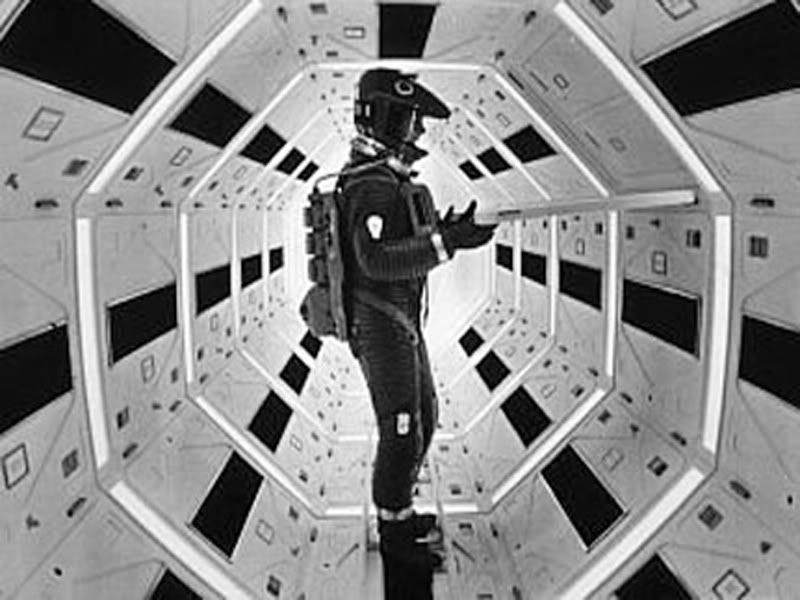
1968’s 2001: A Space Odyssey is widely considered by popular consensus to be the greatest sci-fi movie ever made, and certainly the most influential. As such, Kirby devotes an entire chapter to detailing the film’s production and integration of science. Director Stanley Kubrik took painstaking detail in scientific accuracy to explore complex ideas about the relationship between humanity and technology, hiring a range of advisors from anthropologists, aeronautical engineers, statisticians, and nuclear physicists for various stages of production. Statistician I. J. Good provided advice on supercomputers, aerospace Harry Lange provided production design, while NASA space scientist Frederick Ordway lent over three years of his time to develop the space technology used in the film. In doing so, Kubrik’s staff consulted with over sixty-five different private companies, government agencies, university groups and research institutions. So real was the space technology in 2001 that moon landing hoax supporters have claimed the real moon landing by United States astronauts, taking place in 1969, was taped on the same sets. Not every science-based film has used science input as meticulously or thoroughly since, but Kubrik’s influence on the film industry’s fascination with science and technology has been an undeniable legacy.
One of the real treats of Lab Coats in Hollywood is the exploration of the two-way relationship between scientists and filmmakers, and how film in turn influences the course of science, as we discuss in more detail below. Between film case studies, critiques and interviews with past science advisors are interstitial vignettes of ways scientists have shaped films we know and love. Even the animated feature Finding Nemo had an oceanography advisor to get the marine biology correct. The seminal moment of the most recent Star Trek installation was due to a piece of off-handed scientific advice from an astronomer. The cloning science of Jurassic Park, so thoroughly researched and pieced together by director Steven Spielberg and science advisor Jack Horner, was actually published in a top-notch journal days ahead of the movie’s premiere. Even in rare spots where the book drags a bit with highly technical analysis are cinematic backstories with details that readers will salivate over. (For example, there’s a very good reason all the kelp went missing from Finding Nemo between its cinematic and DVD releases.)
As the director of a creative scientific consulting company based in Los Angeles, one of the biggest questions I get asked on a regular basis is “What does a science advisor do, exactly?” Lab Coats in Hollywood does an excellent job of recounting stories and case studies of high-profile scientist consultants, all of whom contributed their creative talents to their respective films in different ways, what might be expected (and not expected) of scientists on set, and of giving different areas of expertise that are currently in demand in Hollywood. Kirby breaks down cinematic fact checking, the most frequent task scientists are hired to perform, into three areas within textbook science (known, proven facts that cannot be disputed, such as gravity): public science, something we all know and would think was ridiculous if filmmakers got wrong, expert science, facts that are known to specialists and scientific experts outside of the lay audience, and (most problematic) folk science, incorrect science that has nevertheless been accepted as true by the public. Filmmakers are most likely to alter or modify facts that they perceive as expert science to minimize repercussions at the box office.
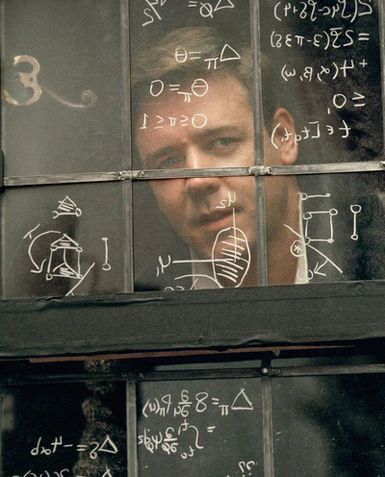
A science advisor is constantly navigating cinematic storytelling constraints and a filmmaker’s desire to utilize only the most visually appealing and interesting aspects of science (regardless of whether the context is always academically appropriate). Another broad area of high demand is in helping actors look and act like a real scientist on screen. Scientists have been hired to do everything from doctoring dialogue to add realism into an actor’s portrayal (the movie Contact and Jodie Foster’s depiction of Dr. Ellie Arroway is a good example of this), training actors in using equipment and pronouncing foreign-sounding jargon, replicating laboratory notebooks or chalkboard scribbles with the symbols and shorthand of science (such as in the mathematics film A Beautiful Mind), and to recreate the physical space of an authentic laboratory. Finally, the scientist’s expertise of the known is used to help construct plausible scenarios and storylines for the speculative, an area that requires the greatest degree of flexibility and compromise from the science advisor. Uncertainty, unexplored research and “what if” scenarios, the bane of every scientist’s existence, happen to be Hollywood’s favorite scenarios, because they allow the greatest creative freedom in storytelling and speculative conceptualization without being negated by a proven scientific impossibility. An entire chapter—the book’s finest—is devoted to two case studies, Deep Impact and The Hulk, where real science concepts (near-Earth asteroid impacts and genetic engineering, respectively) were researched and integrated into the stories that unfolded in the films. (Side note: if you are ever planning on being a science advisor read this section of the book very carefully).
In years past, consulting in films didn’t necessarily bring acclaim to scientists within their own research communities; indeed, Lab Coats recounts many instances where scientists were viewed as betraying science or undermining its seriousness with Hollywood frivolity, including many popular media figures such as Carl Sagan and Paul Ehrlich. Recently, however, consultants have come to be viewed as publicity investments both by studios that hire high-profile researchers for recognition value of their film’s science content and by institutes that benefit from branding and exposure. Science films from the last 10-15 years such as GATTACA, Outbreak, Armageddon, Contact, The Day After Tomorrow and a panoply of space-related flicks have attached big-name scientists as consultants (gene therapy pioneer French Anderson, epidemiologist David Morens, NASA director Ivan Bekey, SETI institute astronomers Seth Shostak and Jill Tartar and climatologist Michael Molitor, respectively). They also happened to revolve around the research salient to our modern era: genetic bioengineering, global infectious diseases, near-earth objects, global warming and (as always) exploring deep space. As such, a mutually beneficial marketing relationship has emerged between science advisors and studios that transcends the film itself resulting in funding and visibility to individual scientists, their research, and even institutes and research centers. The National Severe Storms Laboratory (NSSL) promoted themselves in two recent films, Twister and Dante’s Peak, using the films as a vehicle to promote their scientific work, to brand themselves as heroes underfunded by the government, and to temper public expectations about storm predictions. No institute has had a deeper relationship with Hollywood than NASA, extending back to the Star Trek television series, with intricate involvement and prominent logo display in the films Apollo 13, Armageddon, Mission to Mars, and Space Cowboys. Some critics have argued that this relationship played an integral role in helping NASA maintain a positive public profile after the devastating 1986 Challenger space shuttle disaster. The end result of the aforementioned promotion via cinematic integration can only benefit scientific innovation and public support.
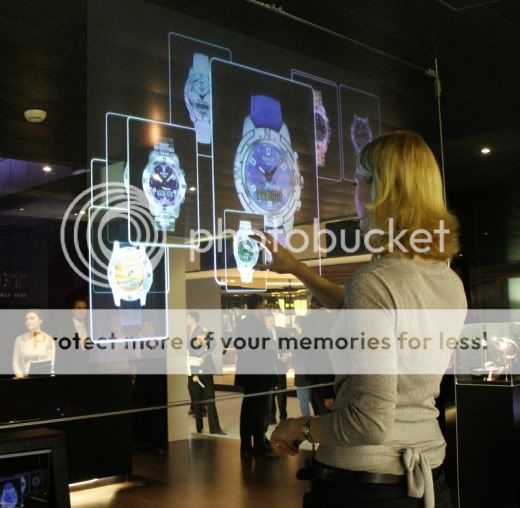
Accurate and favorable portrayal of science content in modern cinema has an even bigger beneficiary than specific research institutes, and that is society itself. Fictional technology portrayed in film – termed a “diegetic prototype” – has often inspired or led directly to real-world application and development. Kirby offers the most impactful case of diegetic prototyping as the 1981 film Threshold, which portrayed the first successful implantation of a permanent artificial heart, a medical marvel that became reality only a year later. Robert Jarvik, inventor of the Jarvik-7 artificial heart used in the transplant, was also a key medical advisor for Threshold, and felt that his participation in the film could both facilitate technological realism and by doing so, help ease public fears about what was then considered a freak surgery, even engendering a ban in Great Britain. Of the many obstacles that expensive, ambitious, large-scale research faces, Kirby argues that skepticism or lack of enthusiasm from the public can be the most difficult to overcome, precisely because it feeds directly into essential political support that makes funding possible. A later example of film as an avenue for promotion of futuristic technology is Minority Report, set in the year 2054, and featuring realistic gestural interfacing technology and visual analytics software used to predict crime before it actually happens. Less than a decade later, technology and gadgets featured in the film have come to fruition in the form of multi-touch interfaces like the iPad and retina scanners, with others in development including insect robots (mimics of the film’s spider robots), facial recognition advertising billboards, crime prediction software and electronic paper. A much more recent example not featured in the book is the 2011 film Limitless, featuring a writer that is able to stimulate and access 100% of his brain at will by taking a nootropic drug. While the fictitious drug portrayed in the film is not yet a neurochemical reality, brain enhancement is a rising field of biomedical research, and may one day indeed yield a brain-boosting pill.
No other scientific feat has been a bigger beneficiary of diegetic prototyping than space travel, starting with 1929’s prophetic masterpiece Frau im Mond [Woman in the Moon], sponsored by the German Rocket Society and advised masterfully by Hermann Oberth, a pioneering German rocket research scientist. The first film to ever present the basics of rocket travel in cinema, and credited with the now-standard countdown to zero before launch in real life, Frau im Mond also featured a prototype of the liquid-fuel rocket and inspired a generation of physicists to contribute to the eventual realization of space travel. Destination Moon, a 1950 American sci-fi film about a privately financed trip to the Moon, was the first film produced in the United States to deal realistically with the prospect of space travel by utilizing the technical and screenplay input of notable science fiction author Robert A. Heinlein. Released seven years before the start of the USSR Sputnik program, Destination Moon set off a wave of iconic space films and television shows such as When Worlds Collide, Red Planet Mars, Conquest of Space and Star Trek in the midst of the 1950s and 1960s Cold War “space race” between the United States and Russia. What theoretical scientific feat will propel the next diegetic prototype? A mission to Mars? Space colonization? Anti-aging research? Advanced stem cell research? Time will only tell.
Ultimately, readers will enjoy Lab Coats in Hollywood for its engaging writing style, detailed exploration of the history of science in film and most of all, valuable advice from fellow scientists who transitioned from the lab to consulting on a movie set. Whether you are a sci-fi film buff or a research scientist aspiring to be a Hollywood consultant, you will find some aspect of this book fascinating. Especially given the rapid proliferation of science and technology content in movies (even those outside of the traditional sci-fi genre), and the input from the scientific community that it will surely necessitate, knowing the benefits and pitfalls of this increasingly in-demand career choice is as important as its significance in ensuring accurate portrayal of scientists to the general public.
~*ScriptPhD*~
***************
ScriptPhD.com covers science and technology in entertainment, media and advertising. Hire our consulting company for creative content development.
Subscribe to free email notifications of new posts on our home page.
]]>
I was recently watching Wall Street: Money Never Sleeps, the sequel to the Oscar-winning 1987 financial cautionary tale. In the middle of a movie that had nothing to do with science, the lead character started explaining the financial investment potential of a national research facility loosely based on the ultra-exclusive National Ignition Facility in Livermore, CA (which ScriptPhD.com was fortunate to visit and profile recently). The film did such an impressive job of explaining the laser technology being used in real life to harness endless quantities of energy from a molecular fusion reaction that it could have easily been lifted from a physics textbook. Translating, explaining and visually presenting complex science on film is not an easy task. It got us to thinking about some of the greatest science and technology moments of all time in film.
In no particular order, with the help of our readers and fans, here are ScriptPhD.com’s choices for the Top 10 gamechangers of science and/or technology cinematic content that was either revolutionary for its time, was smartly conceived and cinematically executed, or has bared relevance to later research advances.
Gattaca
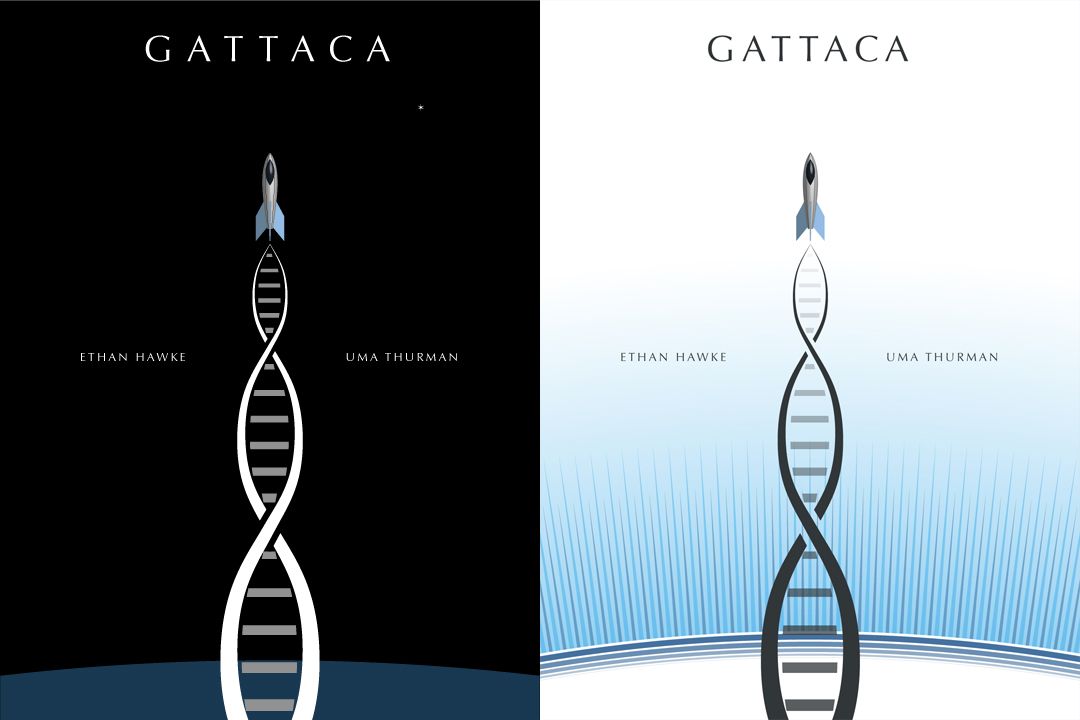
A trend-setter in genomics and bioinformatics, long before they were scientific staples, 1997 sci-fi masterpiece Gattaca has some of the most thoughtful, smart, introspective science of any film. To realize his life-long dream of space travel, genetically inferior Vincent Freeman (Ethan Hawke) assumes the DNA identity of Jerome Morrow (Jude Law), but becomes a suspect in the murder of the space program director. Not only is this the first (and only) movie to have a clever title composed solely of DNA sequence letters (G, A, T and C are the nucleotide bases that make up DNA), it was declared by molecular biologist Lee M. Silver as “a film that all geneticists should see if for no other reason than to understand the perception of our trade held by so many of the public-at-large.” In 1997, we were still 6 years away from the completion of the Human Genome Project. Post that feat of modern biotechnology, the ability to obtain ‘personal genomics’ disease profiles has led bioethicists to question who is to be entrusted with interpreting personal DNA information, and the United States Congress to pass the Genetic Information Non-Discrimination Act. Could we find ourselves in a world that judges the genetically perfect as ‘valids’ and anyone with minor flaws (and what constitutes a flaw?) as ‘invalids’? The eugenic determinism in Gattaca certainly portrays an eerily realistic portrait of such a world.
Contact

Voted on by several of our Facebook and Twitter fans (in complete agreement with us), Contact (based on the book by the most important astronomer of our time, Carl Sagan) is an astonishingly smart movie about the true meaning of human existence, explored through the first human contact with intelligent extraterrestrials. Rarely ambitious and quietly thoughtful science fiction for a big-budget movie, Contact is also one of the best explorations of the divide between science and religion. Bonus points for Jodie Foster’s eloquent and dedicated portrayal of what a real scientist is like.
A Beautiful Mind
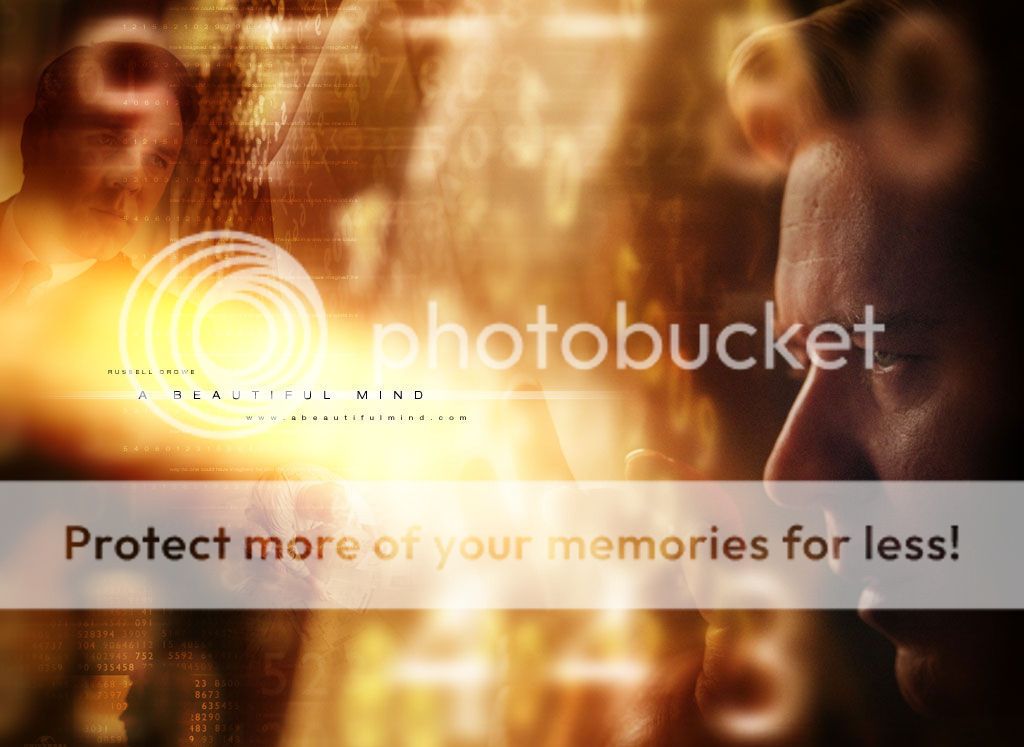
It’s not often that cinema even touches mathematics or physics with depth and significance. It’s even rarer to see complex mathematics at the center of a poignant plot. 2001 Academy Award winning drama A Beautiful Mind was inherently not a film about mathematics, but rather one man’s quest to overcome a debilitating mental illness to achieve greatness. Nevertheless, the presentation of abstract mathematics, notably the Nash equilibrium that won John Nash the Nobel Prize in Economics in 1994, is not only difficult to do in film, but is done extraordinarily well by director Ron Howard. For anyone that has studied high-level math, or known a math professor, this film gives a picture-perfect portrayal, and possibly inspired a new generation of aspiring mathematicians.
2001: A Space Odyssey
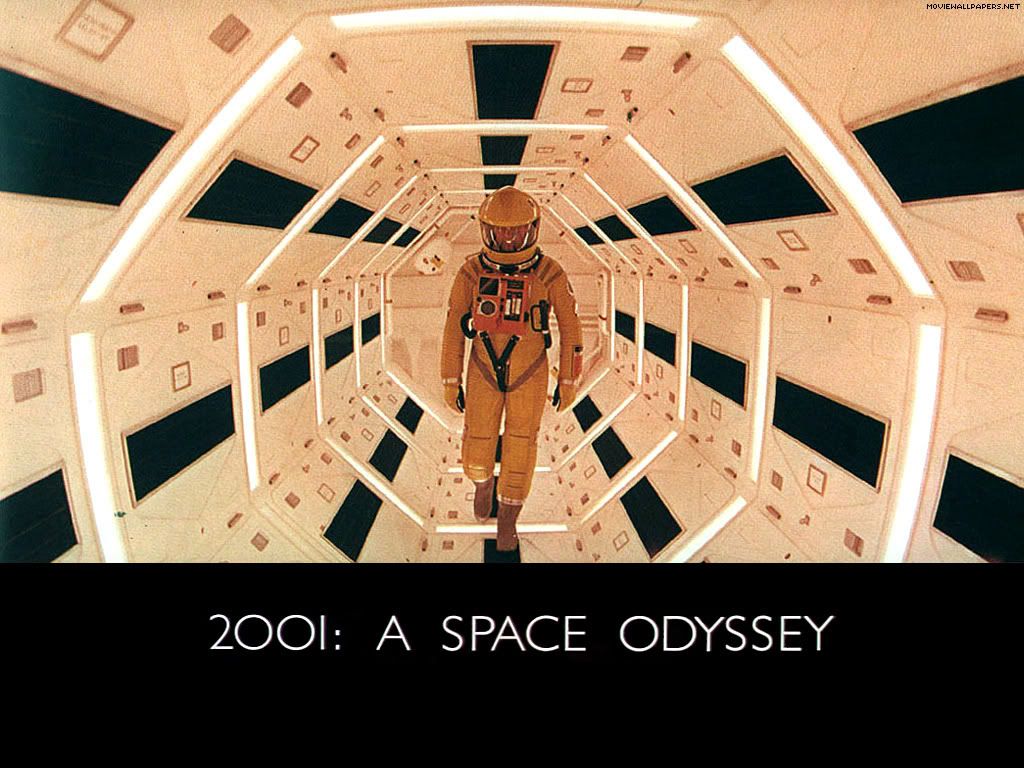
2001: A Space Odyssey is the greatest sci-fi film ever made. Period. Kubrik’s classic introduces an ahead-of-its-time exploration of human evolution, artificial intelligence, technology, extraterrestrial life and the place of humanity in the greater context of the universe. Although definitively esoteric in its content, individual elements could be lifted straight from a science textbook. The portrayal of an ape learning to use a bone as a tool and weapon. Missions to explore outer space, including depictions of alien life, spacecraft and computers that are so realistic, they were built based on consultations with NASA and Carl Sagan. The Heuristic ALgorithmic computer (HAL) that runs the ship’s operations is depicted as possessing as much, if not more intelligence than human beings, an incredibly prescient feat for a film made in 1968.
The Day The Earth Stood Still
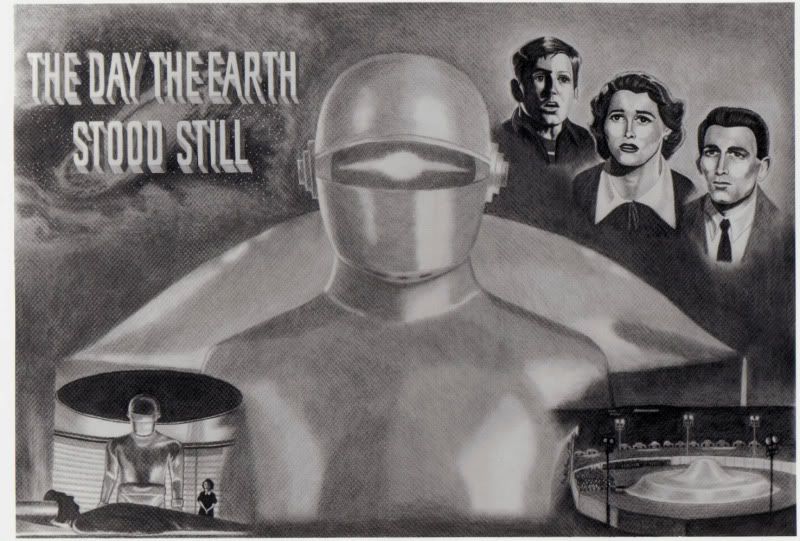
The Day the Earth Stood Still (we speak of the original, and not its insipid 2008 remake) is a seminal film in the development of the big-budget studio sci-fi epics. Given its age (the original came out in 1951), it still stands the test of time as a warning about the dangers of nuclear power. Well-made, sophisticated and not campy, TDTESS is one of the best cinematic emblems of the scientific anxieties and realities of the Cold War and nuclear era. It is usually a staple of Top Sci-Fi lists.
Jurassic Park
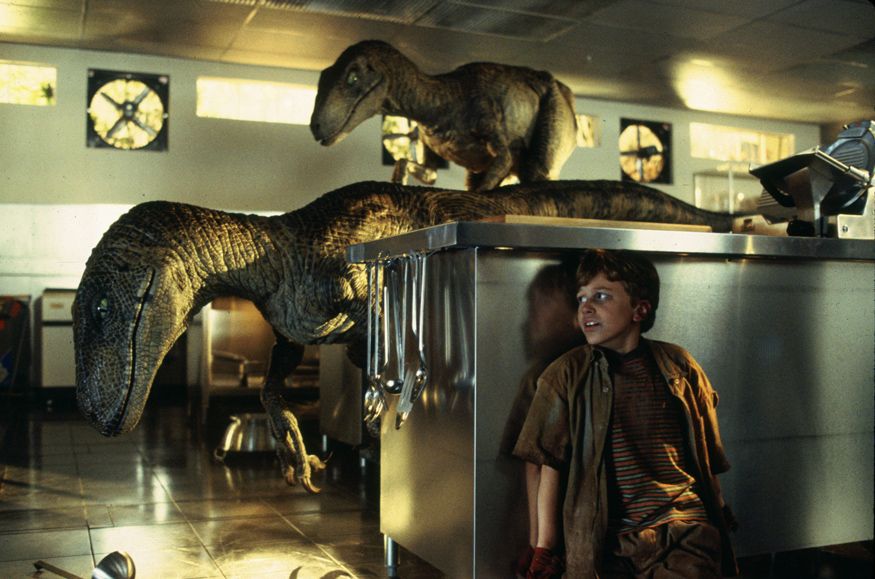
Jurassic Park, originally released in 1993, set one of the most important landmarks for modern science in film—the incorporation of DNA cloning as a significant plot element three full years BEFORE the birth of Dolly, the cloned sheep. Even more important than the fact that, although highly improbable, the science of Jurassic Park was plausible, is the idea that it was presented in an intelligent, casual and meaningful way, with the assumption (and expectation) that the audience would grasp the science well enough not to distract from the rest of the film. Furthermore, the basic plot of the film (and the book on which it was based) act as a cautionary tale about the dangers of unchecked scientific experimentation, and the havoc it can wreak when placed in the wrong hands. With the completion of the Human Genome Project in 2003, and the ability to sequence an organism’s genome in a day, bioethical questions about how personal genomics and the resurgent gene therapy are used are perfectly valid. Jurassic Park set a new standard for how modern science would be incorporated into movies.
Terminator 1 and Terminator 2

The Terminator?! Sounds campy, I know. We associate these adventure blockbuster films more with action, explosions and the rise of Arnold Schwarzenegger. Not game-changing science. Think again. The cyborg technology presented in these 1984/1991 action adventures was not only far ahead of its time scientifically, but smart, conceptual, and has really stood the test of time. Countless engineers and aspiring scientists must have been inspired by the artificially intelligent robots when the film first premiered. Today, with robotics technology enabling everything from roomba vacuum cleaners to automated science research, many engineers postulate that the day could even come that humanoid robots could someday fight our wars. Earlier this year, scientists at the German Aerospace Center even created the first ‘Terminator’-like super strong robot hand!
Apollo 13
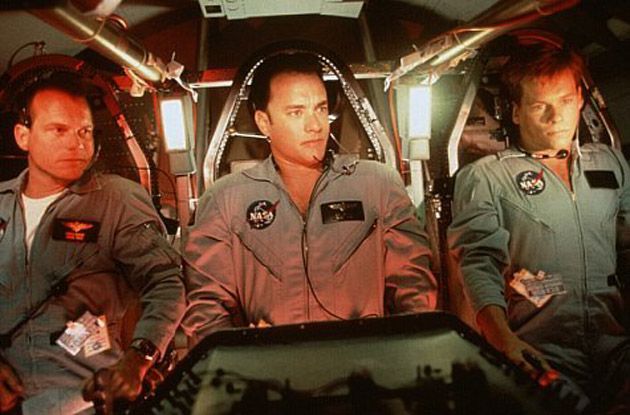
Space. The final frontier. At least in the heart of the movies. Far beyond the sci-fi genre, space travel, extraterrestrial life, and NASA missions remain a potent fascination in the cinematic world. For its feat as one of the most factually-correct space travel films ever made, with pinpoint portrayal of a monumentally significant event in the history of American science and technology, Apollo 13 enthusiastically lands on our list. Ron Howard’s almost-obsessive dedication to accuracy in detail included zero gravity flights for the actors (in addition to attending US Space Camp in Huntsville, AL), studying the mission control tapes, and an exact redesign of the layout of the Apollo spacecraft controls. Not only does the story inspire the spirit of adventure and innovation, it is 100% true.
The Andromeda Strain
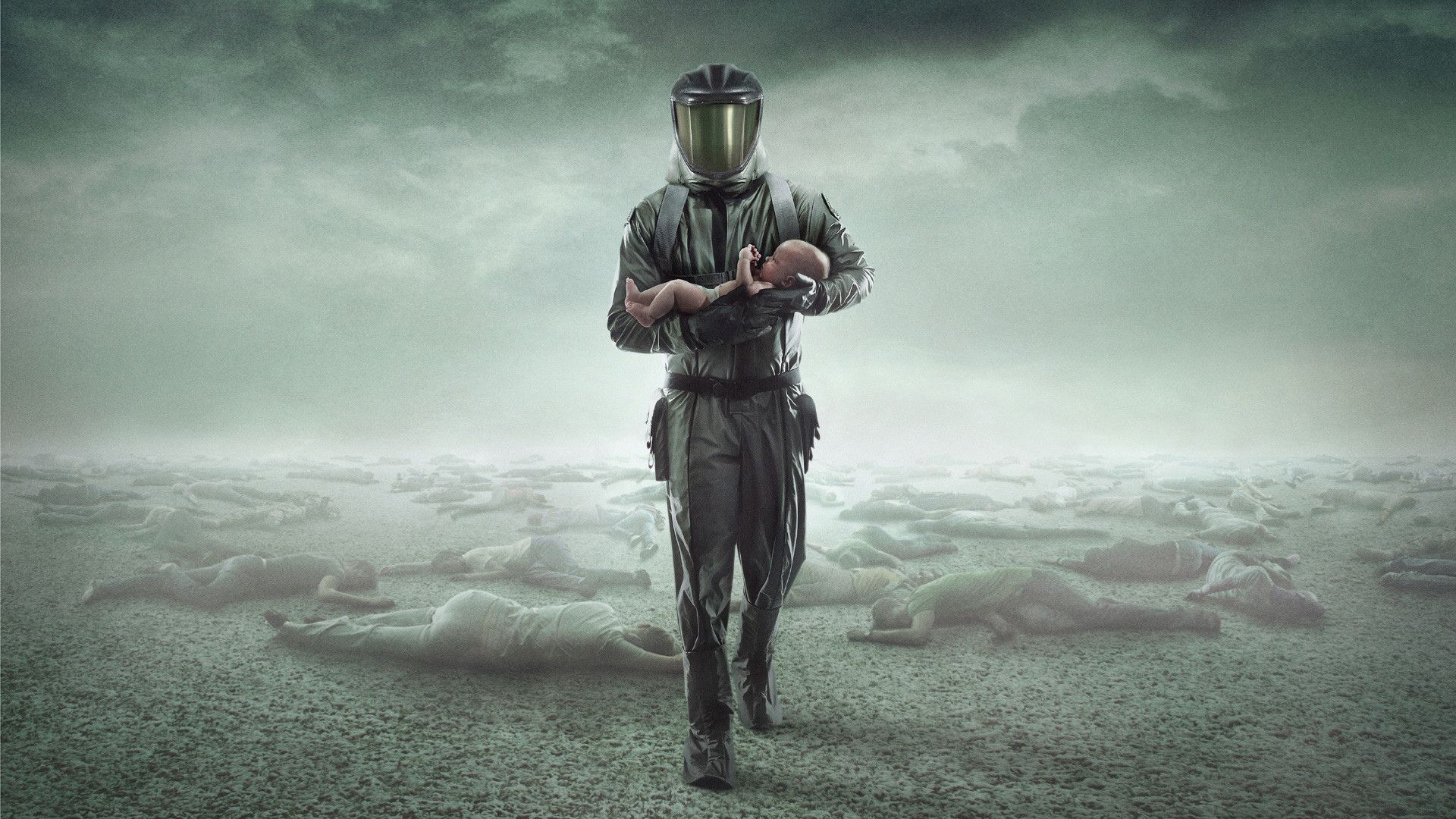
For a film made in 1971, The Andromeda Strain (based on Michael Crichton’s novel by the same name) is a remarkably modern and prescient movie that has had a lot of staying power. The first really significant bio thriller film made, Andromeda’s killer viruses, transmissibility, and global infections have become de rigeur in our modern world. In the film, a team of scientists investigate a deadly organism of extraterrestrial origin that causes rapid, deadly blood clotting—perhaps an unintentional foreboding of Ebola and other hemorrhagic viruses. While the idea of a terrifying pandemic or biological emergency has certainly been replicated in many films such as Outbreak and 28 Days Later, no film has done a better job of capturing not just the sheer terror of an unknown outbreak, but the science behind containment, including government organization, the team of scientists working in a Biosafety Level-4 laboratory, and the fact that the story doesn’t overshadow the focus on the research and lab work. (Incidentally, as far-fetched as Crichton’s plot seemed to be at the time, recent research has shown that Earthly microbes traveling with US astronauts gained strength and virulence in space!)
Moon

One of the most recent films to crack our Top 10 list, 2009’s debut gem from sci-fi director Duncan Jones failed to amass an audience commensurate to its brilliance and modern scientific relevance. A sweeping, gorgeous epic in the shadow of (and certainly inspirited by) 2001: A Space Odyssey, Moon (ScriptPhD.com review) tells the story of Astronaut Sam Bell (Sam Rockwell), who is at the tail-end of a three-year solo stint on the Moon, mining for Helium-3 resources to send back to an energy-depleted Earth. As the sole employee of his lunar station, Bell works alongside an intelligent computer named GERTY (Hal’s third generation cousin), but on the heels of his return to Earth, uncovers an insidious plot by the company he works for to keep him there forever. There are so many scientific and technology themes that made this an obvious choice for our list. Moon exploration and human colonization has been a hot topic for at least the last 15 years, with a recent discovery that the Moon may have as much water as the Earth sure to fuel possible NASA exploration and additional Moon missions. The ethical morass of a greedy company with technology capabilities cloning an employee is not only done brilliantly, but evokes a realistic, chilling possibility in our evolving scientific landscape. Finally, Sam’s relationship with GERTY (voiced by Kevin Spacey), who ultimately transcends his robotic limitations to exercise free will in helping Sam escape the pod, is especially poignant as technology becomes a more intimate part of human life and literally changes our neurological makeup.
~*ScriptPhD*~
*****************
ScriptPhD.com covers science and technology in entertainment, media and advertising. Hire our consulting company for creative content development.
Subscribe to free email notifications of new posts on our home page.
]]>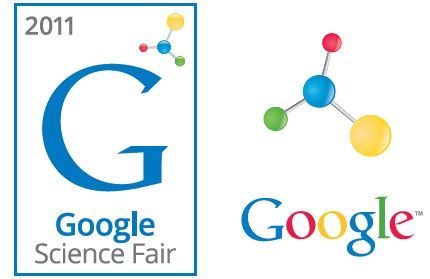
In his State of the Union speech in January, US President Barack Obama proclaimed that “we need to teach our kids that it’s not just the winner of the Super Bowl who deserves to be celebrated, but the winner of the science fair.” A noble (and correct) assessment, to be sure, but one mired in numerous educational and cultural obstacles. For one thing, science fairs themselves are at a perilous crossroads. A New York Times report issued in February stated that not only is participation in science fairs among high school kids falling, but that the kind of creativity and independent exploration that these competitions necessitate is impossible under current rigid test-driven educational guidelines for teaching mathematics and science. Indeed, an interesting recent Newsweek article on “The Creativity Crisis” conveyed research studies showing that for the first time, American creativity is declining. How appropriate, then, that this April (national math education month) brings the culmination of the Google World Science Fair, the first ever competition of its kind transpiring online and open to lab rats from all over the globe. ScriptPhD.com discusses why this could be a game-changer for the next generation of young scientists, under the “continue reading” cut.
One of the most chilling chapters in Thomas Friedman’s brilliant 2005 book “The World is Flat” discusses the ramifications of the globalization of science, and how quickly America is getting left behind. In addition to global “flatteners” (connectors) such as the internet, outsourcing, and yes, even access to free information via Google, Friedman details how hard third-world nations such as India and China work to attain supreme educations in math and science. On the one hand, they are producing more raw talent than ever, which often (due to lack of job opportunities and world-class facilities) finds its way into American (and Western) laboratories and corporations. On the other hand, it leaves American students and scientists ill-prepared to compete in a globalized economy based on information rather than raw production. (See Tom’s talk about global flattening at MIT here.) China will surpass the United States in patent filings by scientists by 2020. They are set to overtake the US in published research output even faster – in 2 years! Disturbingly, US teens ranked 25th out of 34 countries in math and science in the most recent world rankings, prompting President Obama to direct $250 million dollars towards math and science education. How that education is conveyed in classrooms is a subject of quite ardent debate.
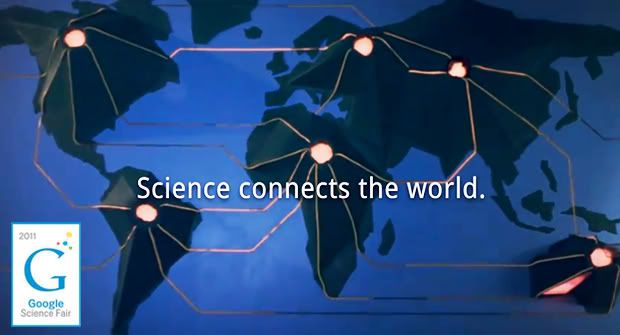
Clearly, science education, in its current incarnation, is not working successfully. Unorthodox curricula have been proposed by numerous academic institutions, and even implemented with success in some countries. Furthermore, the idea of iconoclasts and self-taught geniuses, left alone to ferment their creativity, is not new. Albert Einstein famously clashed with authorities in primary school (which he barely finished), noting that “the spirit of creativity and learning were lost in strict rote learning.” In 2009, self-taught college dropout Erik Anderson proposed a major new theory on the structure of spiral galaxies and published it in one of the world’s most prestigious journals. (See ScriptPhD.com’s excellent post on whether creativity can really be measured in the lab.) Enter the Google World Science Fair. Capitalizing on the web and social media-driven knowledge of the current generation, they aim to not only expand on traditional well-known science competitions like Intel and Siemens, but to catapult them into the modern Internet era. Concomitantly, and even more importantly, as the fair’s organizers relayed over the weekend to the New York Times, they wish to improve science and math education in America incorporating a brand that many kids are already familiar with and use with ease. Why not infuse the excitement of a Google search into the staid, antiquated methodologies afflicting much of math and science curricula today? The impacts of science and independent experimentation are wide-reaching and powerful. During a gathering of scientists, students and judges on the day of the science fair announcement at Google headquarters, African self-taught scientist William Kamkwamba shared how from a library book, he was able to build a wind mill that powered his large family’s house, brought water to his impoverished village, but then taught other villagers to build wind mills, and by proxy, improved schools and living conditions. Who knows how many of this year’s global entrants will make such sizable contributions to their communities, or even, as they’re encouraged to do, solve global-scale afflictions?
Beyond the originality factor, he Google competition is important in several ways. It’s virtual and literally open to anyone in the world so long as they are a student between the ages of 13-18, thereby negating the most obvious roadblock to participation in many science competitions: location and affordability. (Though studies argue that internet access is still an overwhelming factor in economic and social equality, which is a not insignificant hurdle for aspiring third world participants.) Secondly, the competition is being judged on a passion for science and ideas, especially those relevant to the world today. In an age when we’re trying to ameliorate diseases, epidemics, the effects of global warming and violently changing weather patterns, urban sprawl and overpopulation, along with an ever-frustrating lack of access to water, food and sanitation by the poor, a few extra ideas and approaches can’t hurt. After all, a 15-year-old Louis Braille invented a system of reading for the blind, 18-year-old Alexander Graham Bell sketched rough ideas for what would turn into the telephone, 14-year-old Philo T. Farnsworth invented the television, and the modern microscope that many entrants will likely use in their experiments was invented by a 16-year-old Anton van Leeuwenhoek! (See more here.)
In the same spirit of hip novelty and digital cleverness that they’ve infused into the age-old science fair, Google hired the team from Los Angeles-based Synn Labs, the same team behind the viral OK Go music video, to create a thirty-second Rube Goldberg-themed video promoting the science fair. It is, perhaps, the highlight of the competition itself! Take a look:
The submission deadline for the 2011 online global science fair is today, April 4, 2011. All information about submission, judging, prizes, and blogs about entries can be found on the Google Global Science Fair homepage. The site also offers resources for teachers and educators looking to gain ways to bring the essence of Google’s science fair into their classrooms. You can also track all projects, as well as interact and exchange ideas with other science buffs, on their Facebook fan page and Twitter page.
ScriptPhD.com encourages all of our readers, clients, and fans who either submitted entries by the deadline, had their kids enter, or know someone who entered the competition to come back and tell us about the experience on our Facebook page. We’d love to hear about it! We wholeheartedly support programs that promote science and innovation, especially applicable to mitigating global social and technological obstacles. Our consulting company mantra is that great creative enterprises are fueled by great ideas. So, too, are science and technology. As such, we applaud Google for reinventing (and virtualizing) science outreach to encourage ideas and transform an entire generation of scientists, regardless of location, education or perceived ability. And if you’re bummed that you missed out on this year’s competition, think of it this way: you have plenty of time to prepare for 2012!
This post was sponsored by Unruly Media.
~*ScriptPhD*~
*****************
ScriptPhD.com covers science and technology in entertainment, media and advertising. Hire our consulting company for creative content development.
Subscribe to free email notifications of new posts on our home page.
]]>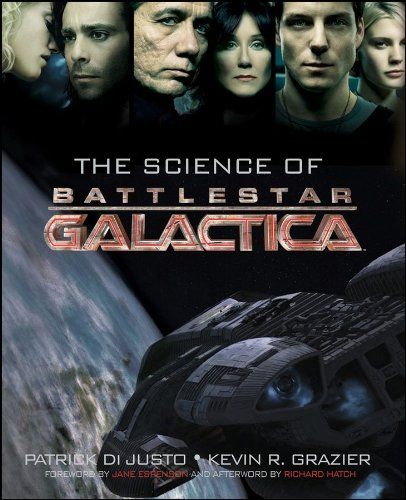
Battlestar Galactica is one of the defining, genre-changing science fiction shows of its, or perhaps any, time. The remake of the 1970s cult classic was sexy, sophisticated, and set a new standard for the science fiction shows and movies that will follow in its path. In addition to exploring staple concepts such as life, survival, politics and war, BSG reawakened its audience to science and its role in moral, ethical, and daily impact in our lives, especially given the technologically-driven era that we live in. “Writers were not allowed to jettison science for the sake of the story,” declares co-executive producer Jane Espenson in her foreword to the book. “Other than in specific instances of intentionally inexplicable phenomena, science was respected.” In an artful afterword, Richard Hatch (the original Apollo and Tom Zarek in the new series) concurs. “BSG used science not as a veneer, but as a key thematic component for driving many of the character stories… which is the art of science fiction.” The sustained use of complex, correct science as a plot element to the degree that was done in Battlestar Galactica is also a hallmark first. This is the topic of the new book The Science of Battlestar Galactica, newly released from Wiley Books, and written by Kevin R. Grazier, the very science advisor who consulted with the BSG writing staff on all things science, with a contribution from Wired writer Patrick DiJusto. Now, for the first time, everyone from casual fans to astrophysicists can gain insight into the research used to construct major stories and technology of the show—and learn some very cool science along the way. Our review of The Science of Battlestar Galactica (and our 100th blog post!) under the “continue reading” cut.

What is life? Seriously. I’m not asking one of those hypothetical existential questions that end up discussed ad nauseum in a dorm room at 3 AM. I’m asking the central question that Battlestar Galactica, and much of science fiction, is based around. The shortest section of The Science of Battlestar Galactica, “Life Began Out Here,” is its most poignant. No matter the conflict, subplot or theme explored on BSG, they ultimately reverted back to the idea of what constituted a living being, and what rights, if any, those beings possessed. It all boils down to cylons. What are they made of? How do their brains (potentially) work? How much information can they contain, and how is it processed from one dead cylon to its next incarnation? How could a cylon and a human mate successfully, and is their offspring (Hera Agathon) the Mitochondrial Eve of that society? How did they evolve? What is the biological difference between raiders, centurions, and humanoid cylons? Who can forget the ew gross factor of Boomer plugging her arm into the cylon computer system, but how could she do that, especially when she was made to act, feel and think as a human being? A brief, smart discussion on spontaneous evolution and basic biology gives way to a thoughtful evocation of our own efforts with artificial intelligence, and the responsibilities that it engenders. Take a look at the website of the MIT iGem Program, an annual competition to design biological systems that will operate in living cells from standard toolkits. Do some of their creations, including bacteria that eat industrial pollutants and treat lactose intolerance, constitute life, and are our own Cybernetic Life Nodes not too far away? The section ends in a fascinating debate over who we are more akin to—the humans of the Battlestar universe (as is widely assumed) or cylons. The answer would surprise you.
The middle of The Science of Battlestar Galactica, composed of “The Physics of Battlestar Galactica” and “The Twelve Colonies and The Rest of Space” reads largely like my college physics textbook, only with far cooler sample problems. If Apollo and Starbuck both launch their vipers at the same time and Starbuck coasts past Apollo, according to special relativity, who is moving? In perhaps the greatest implementation of Einstein’s famous theory in science fiction, special relativity explains how Starbuck could explain that she wasn’t a Cylon when she returned unharmed from the dead, and why her viper looked brand new. A special look at radiation particularly interested me, with a chemistry background, as it thoroughly delved into the chemistry and physics of radiation, heat-seeking missile weapons, DNA damage, and the power of nuclear weapons, both with fictional examples (the destruction of Caprica) and real (Japan and Chernobyl). The chapters on relativity (E=mc2) and the Lorentz Contraction reminded me of a seminar on dark energy that we covered at the Hollywood Laserium presented a year ago by Dr. Charles Baltay (NOT Baltar!), the man who was responsible for Pluto losing its planetary status. At the time, a lot of the concepts seemed a bit esoteric, but having read this book, are now elementary. Did you know, for example, that a supernova explosion is so powerful, it can briefly cause iron and other atoms remaining in the star to fuse into every naturally occurring element in the periodic table? Nifty, eh? Astronomy buffs, amateur and experienced, will enjoy the section on space, with a preamble on the formation of our galaxy and star systems to the 12 different planets of the Colonies, and how that many habitable planets could all be packed into such a dense area (see companion map below).
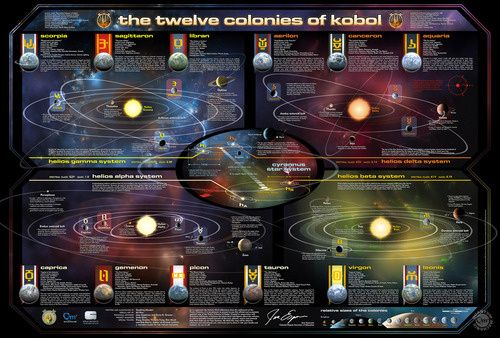
With perfect timing for the publication of The Science of BSG, Kevin R. Grazier and co-executive producer Jane Espenson have teamed up to create a plausible astronomy map of the 12 colonies of Battlestar Galactica. Find a larger, interactive version here.
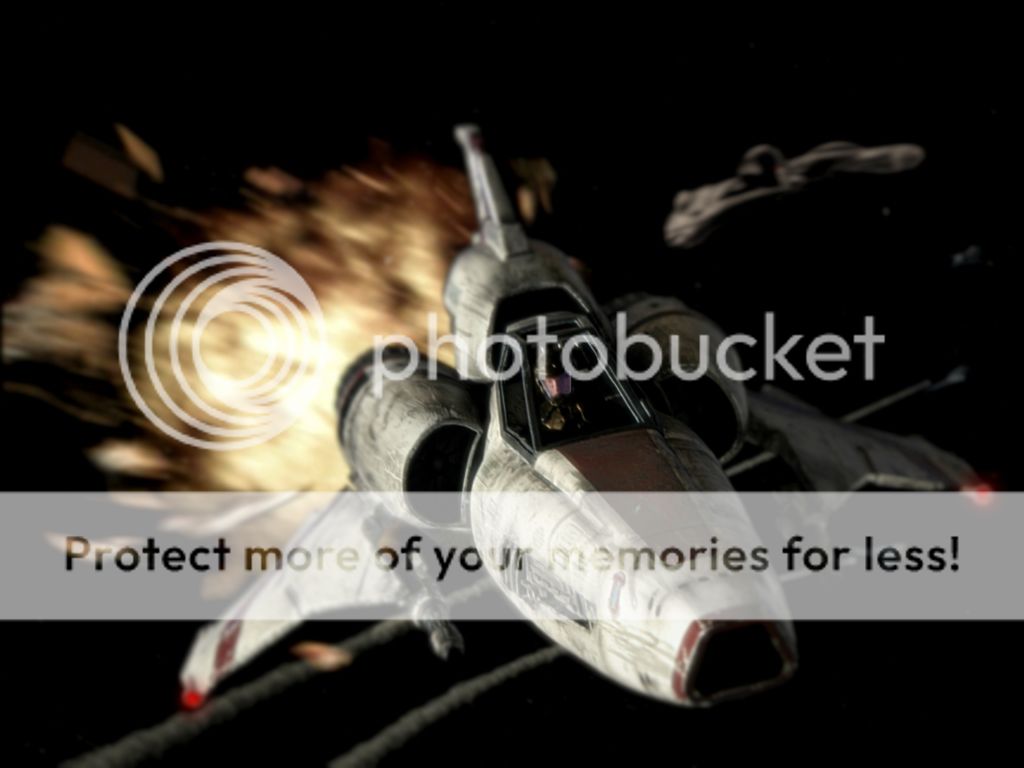
One of the more fun aspects to watching BSG was the cornucopia of weapons, toys, and other electronics used by both humans and Cylons, a subject explored in the most meaty section of the whole book, “Battlestar Tech.” This includes a discussion of propulsion and how the Galactica’s jump drive might work, artificial gravity, a great chapter on the vipers and raptors as effective weapons, and positing how it is that Six was able to infiltrate the colonial computer infrastructure… besides the obvious, that is. I really enjoyed learning about Faraday cages, tachyon particles, brane cosmology, and what a back door is in computer programming, terms you can bet I will be throwing out casually at my next hoity-toity dinner party. The next time you rewatch an episode, and hear Mr. Gaeta utter a directive such as “We have a Cylon raider, CBDR, bearing 123 carom 45,” not only will you know exactly what he’s saying relative to the cartesian coordinates of the BSG space universe, but how this information is used to operate the complicated three-dimensional space system that the pilots have to operate in. Finally, critics such as myself of the dilapidated corded phones used aboard the Galactica will be interested to find out why they may have actually been a good idea in protecting the fleet from Cylon detection.
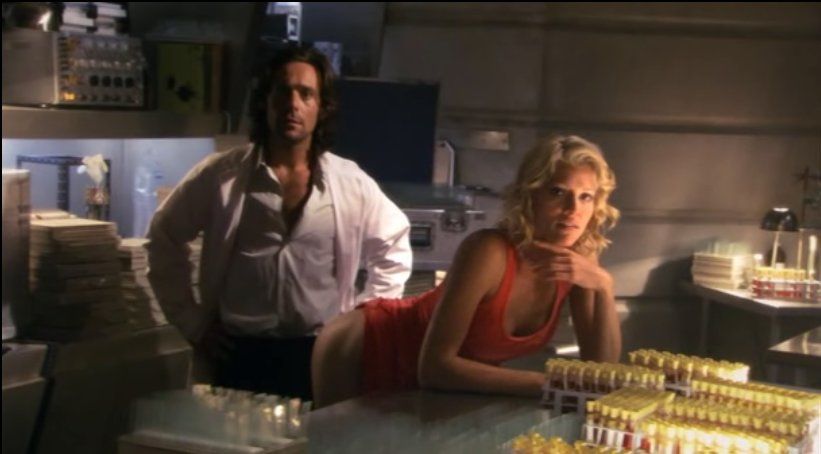
The ultimate selling point of this book is its ability to present material that will appeal to all fractions of a very diverse audience. The writing style is fluid, clever, informative and appropriately humorous in the way one would expect of a geeky sci-fi book (highlighted by a chapter on Cylon composition and detection thereof by Dr. Baltar written in dialogue format between an omniscient scientist and a smart-aleck fanboy). In fact, the co-authors merge their styles well enough so as to imagine that only one person wrote the book. Part textbook, part entertainment, part series companion, The Science of Battlestar Galactica is concomitantly smart, complicated, approachable and difficult—it does not surprise us one bit that in the couple of short months since its wide release, talk of numerous literary awards has already been circling. In between lessons on basic biology, astrophysics, energy and basic engineering are sprinkled delightful vignettes of actual on-set problem solving involving science. My favorites included plausible ways Cylons could download their information as they’re reborn (get ready for some serious computer-speak here!), an excellent explanation of Dr. Baltar’s mysterious Cylon detector, radiation and the difference between uninhabitable ‘dead Earth’ and barely habitable New Caprica, and the revelation by Dr. Grazier of how he had to—in a frantic period of 24 sleepless hours—construct a theory as to how the FTL drive works for an episode-specific reason. Much like the show it is based on, this book asks as many questions as it answers, most notably on social parables within our own world. Are we on our way to building Cylon artificial intelligence? Could our computer infrastructure ever get compromised like the ones on Caprica? Would we ever be able to travel to parallel universes, and what would be the implications of life forms besides our own? How might they even detect our presence?
Read our in-depth interview with Kevin R. Grazier here
Join our our Facebook fan page for a special giveaway commemorating the release of The Science of Battlestar Galactica and our 100th blog post. Now if you’ll excuse me, having read and absorbed this illuminating volume, I have been inspired to go and watch the entire series from start to finish all over again!
~*ScriptPhD*~
*****************
ScriptPhD.com covers science and technology in entertainment, media and advertising. Hire our consulting company for creative content development.
Subscribe to free email notifications of new posts on our home page.
]]>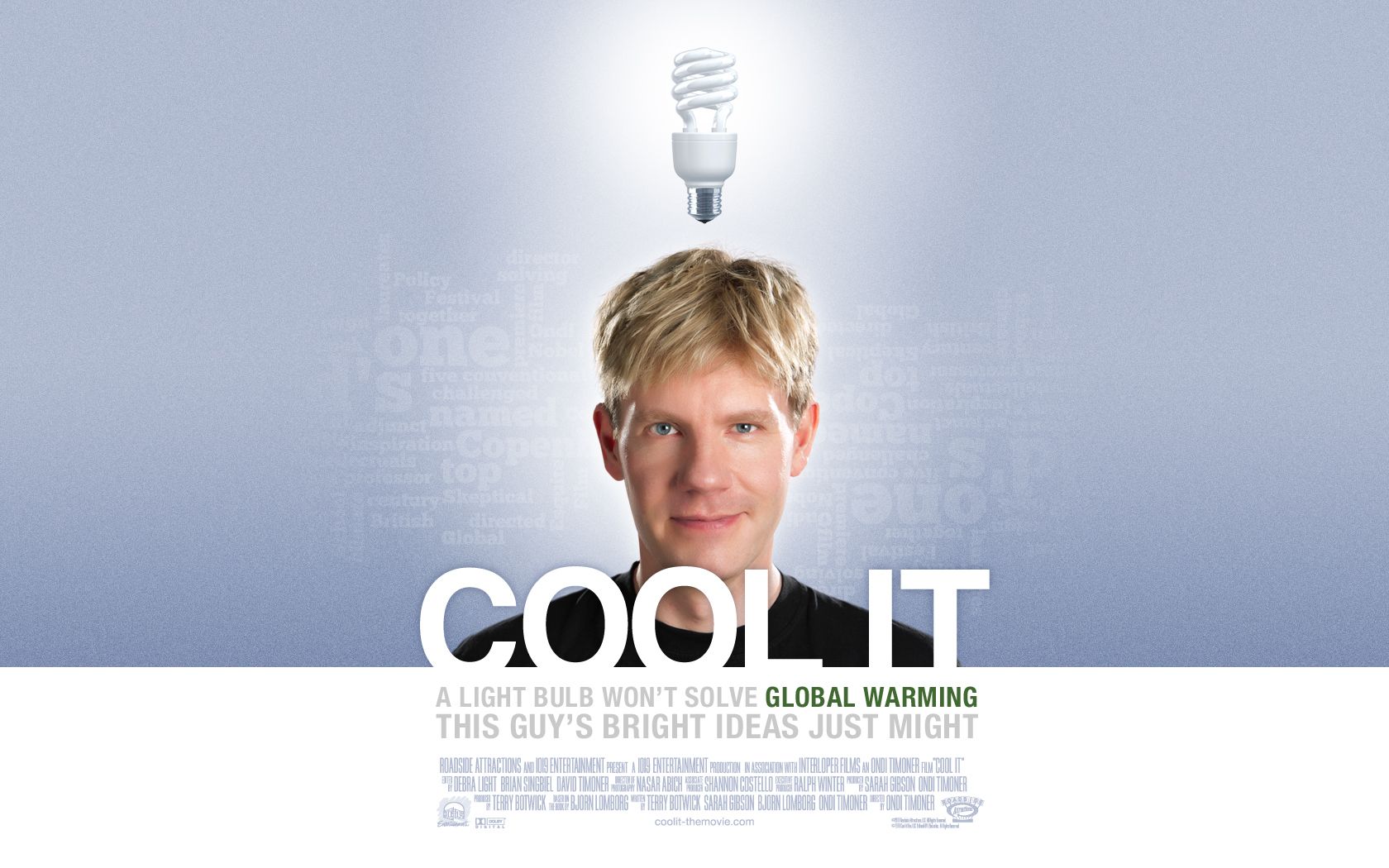
Fewer topics in contemporary science and technology policy have generated as much controversy or vociferous debate as global warming (more recently branded as climate change) and more importantly, how to mitigate its effects. Recent international treaties such as The Kyoto Protocol and conferences such as last December’s United Nations Climate Change Conference in Copenhagen have largely paid lip service towards actionable change and technology aimed at eradicating the precursors and causes of global warming. In the middle of this stalemate is an increasingly hostile rhetoric that has bifurcated into two divergent, unyielding camps—either you believe climate change and greenhouse emissions are a fraud, period, or you believe the problem is so imminently dire that surely, the end of the world is nigh. This dichotomy was no more apparent than during last year’s ”Climategate” controversy, in which hacked emails leaked from the University of East Anglia’s Climatic Research Unit in England were interpreted, depending on which report you read, as scientific fraud and tampering or reinforcement for climate science. Perhaps it is time, as the eponymous title of our latest Editor’s Choice suggests, for us all to Cool It. An environmental film about 21st Century problems, and the modern solutions they necessitate, Cool It presents an unapologetic, practical approach towards global warming and the problems that eclipse it. It’s time we all listened. ScriptPhD.com continues our ongoing “It’s Not Easy Being Green” series with a review of this thought-provoking, conversation-starting film. After seeing a recent screening in Los Angeles, we are proud to give Cool It our blog’s rare highest honor—Editor’s Choice. Join the conversation now under the “continue reading” cut.
A (Very) Brief History of Climate Change in Media and Entertainment

In 1896, Swedish chemist Svante Arrhenius made the first observation that fossil fuel combustion had a correlation to global warming. Discovery Channel has a terrific interactive on the history of scientific discovery in climate change here. It wasn’t until 1962, when a serialized novel called Silent Spring by Rachel Carson was published in The New Yorker magazine, that the issue took forefront in the public media. Considered one of the most influential works in the area of climate change, Silent Spring gives a meticulous account of how the pesticide DDT enters the food chain and accumulates in the fatty tissues of animals, including human beings, and causes cancer and genetic damage. Because of her book, President John F. Kennedy ordered his Science Advisory Committee to look into the book’s claims (use of DDT has since been banned, much to the consternation of bedbug sufferers everywhere!). President Nixon went on to pass the Clean Air Act and create the Environmental Protection Agency, which now has the power to regulate harmful greenhouse gas emissions. Another major milestone for climate change in modern media was the 2006 release of Al Gore’s Oscar-winning film An Inconvenient Truth, which has been given credit not only for re-energizing the environmental movement, but for raising the profile of global warming. (Cool It has been referred to as an “anti-Inconvenient Truth,” but we’ll get to that in a moment.) Marketing and advertising are never far behind the cultural zeitgeist, as green branding has been one of the most successfully growing sectors in the industry. An article in Advertising Age in April of 2010 listed the 10 Green Marketing Milestones of our time.
Who is Bjørn Lomborg and Why is He So Controversial?
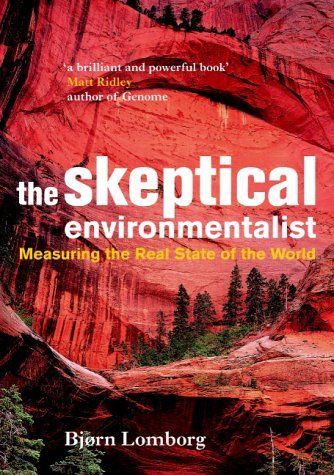
In 2001, a then-unknown adjunct professor at the Copenhagen Business school named Bjørn Lomborg published a book called The Skeptical Environmentalist, which claimed that not only were some of the more dire claims of pending environmental catastrophe exaggerated, but that they were flat-out wrong. Though a carefully-researched volume, the central thesis of Environmentalist was anathema to the academic climate community, and caused an immediate hailstorm on both sides of the climate change spectrum. Accusations of scientific dishonesty, one of the most austere charges within academia, were brought forth by several environmental scientists to the Danish Committees on Scientific Dishonesty. Their finding was mixed, ruling that The Skeptical Environmentalist was scientifically dishonest, but absolving Lomborg himself due to his “lack of expertise” in the field. The decision was later annulled by the Ministry of Science, Technology and Innovation, citing a lack of proof and specific standards. Lomborg has remained a polarizing, contentious figure ever since.

Lomborg, since named one of the 100 most influential people by Time magazine, is now the director of the Copenhagen Consensus Center, where he brings together some of the world’s top economists, including five Nobel laureates, to brainstorm how to solve the world’s most pressing problems. He followed up his first book with another eco-centered piece, Cool It, that offers an alternative platform for the trillions of dollars of current funding aimed at counteracting (often ineffectively) the effects and sources of global warming. In no way denying the very real phenomenon of climate change, Cool It is instead a polemic on contemporary global problems that merit our action and attention right now and that, if solved, will simultaneously obviate climate effects as a bonus. With the help of Director Ondi Timoner, Lomborg has translated Cool It into an extremely interesting, thought-provoking and entertaining documentary. ScriptPhD.com got a sneak peek in Hollywood a couple of weeks ago.
REVIEW: Cool It
ScriptPhD GRADE: A
“Fear has been ruling the climate debate,” declares Lomborg in the opening minutes of Cool It, proclaiming what is a sort of mantra for this film. Fear sells. Fear opens eyes. Fear declares attention. (Read our piece on The Science of Fear.) But fear drowns out messages in hyperbole and bombast. Far from decrying the looming reality of climate change and global warming, Lomborg is simply suggesting that it isn’t the impending catastrophe that media and scientists have ingrained us to believe. Fueling these misconceptions, Lomborg believes, are popular culture messages and movies that simply exaggerate claims, and do nothing to add to a productive conversation about global warming. Take a look, for example, at the opening film shown at the United Nations Climate Change Conference 2009 (COP15) in Copenhagen from the Ministry of Foreign Affairs of Denmark and decide for yourselves if its hyperbolic, fear-fueled message is more about solutions or rhetoric:
This, a commercial for planestupid.com that attempts to correlate airplane emissions to extinction of polar bears:
Turns out that the Kyoto Protocol, if enacted to its full potential, would only save one polar bear per year lost to the effects of global warming. This does nothing to ameliorate a far bigger problem—we shoot 300-500 polar bears to death every year!
“When is something fashionable and when is it rational?” Lomborg asks us. In 2010, hundreds of millions of people participated in Earth Hour, a collective global undertaking to turn off our lights for an hour. Many of the participants undoubtedly lit candles instead, which unfortunately emit twice the CO2 emissions of a light bulb! The 20 trillion in proposed global funding, even if appropriated, will only result in a 0.1 ºF temperature effect by the end of the century. Cap and trade, the Kyoto Protocol and even this past year’s Copenhagen conference, Lomborg asserts, are a waste of time and money that perpetuate decades-old failed promises. Furthermore, the only way for poor countries to climb out of penury and into first-world status is by burning coal and consuming energy. It’s simply unrealistic to think otherwise. The problems that keep Lomborg up at night—AIDS, malaria, disease, lack of access to clean drinking water—are far more important to third world countries than global warming. Nothing illustrates the schism in priorities better than the juxtaposition of two classroom scenes, one in rural Africa and one in urban England. In each case, Lomborg asks the students what their priorities are, what they wish for and what frightens them. To a one, the African students wish for basic luxuries that we take for granted, such as a house and a car, with most rating their top priority as health care. The British students, warm, safe, comfortable, and fed, worried mostly about global warming and our planet’s demise, drawing pictures and describing scenarios that would make Edgar Allan Poe cower in a fetal position.
The second-half of Cool It, far from harboring anti-climate change beliefs, largely focuses on the science and technology advances that must occur to a) counteract global warming, b) make energy, and especially alternative energy, cheaper and c) solve some practical problems in the meantime. Solar panels, for example, are still ten times more expensive than fossil fuels, while unsightly and space-hungry wind turbines face a “not in my backyard” backlash from communities. Revolutionary advances such as energy garnered from water-splitting (read ScriptPhD.com’s recent article on this very phenomenon at The National Ignition Facility), and artificial photosynthesis present amazing potential to create unlimited sources of cheap energy. Lomborg interviews former Microsoft CTO, scientist Nathan Myrvold, whose idea machine includes inventions such as a nuclear energy reactor fueled by waste at a cost competitive to coal. Clearly in awe of scientists, Lomborg touches on adaptation—the notion that global warming, and certain inconveniences thereof, will impact humanity, but that we can counteract these effects through smart technology. The Dutch, 60% of whom live below the sea level, experienced a far more devastating flooding than Hurricane Katrina in 1953, and have since erected the world’s best levees. Urban cooling, such as painting all rooftops white, would impact temperatures in global warming hotspots such as Los Angeles as much as 5 ºC at a one-time cost of $1 billion. He also touches on possibilities within the highly-contested field of geo-engineering, to date largely considered a sci-fi concept, wherein global warming is literally reversed with science. Cloud brightening to reflect more solar light into space and cool the planet, volcano mimics in the stratosphere for the same purpose, experiments to literally suck the CO2 out of the air, regenerative grazing for raising farm animals—all hold immense promise for future generations.
To be sure, Cool It has an agenda, inasmuch as An Inconvenient Truth, or any other subjective work espousing a decided point of view. At ScriptPhD.com, it is not our position to wholly agree or disagree with either position, but rather to applaud the ideas they represent, and to continue a dialogue that will eventually lead to solutions. “No matter what I found over the next year,” said filmmaker Ondi Timoner of undertaking this endeavor with Lomborg, “It was worth taking on this project to see if perhaps I could create a film that would help push through the polarizing logjam that had become the never-ending (and extremely expensive) climate debate towards real and practical solutions.” It’s time to face the facts that changing one light bulb or driving one Prius, no matter how well-meant, simply isn’t going to change the world alone. It’s time to also admit that the contentious, argumentative, ineffective stale-mate that has become the climate debate is serving no one, least of all the worst-off populations needing clean water, health care and technology. Over-exaggerated, frightening tales might sell movies and commercials, but they don’t get bills passed, and they don’t apportion funds for smart, permanent solutions and scientific advancement. Love him or hate him, but Lomborg is 100% on-point in that regard. Whatever side of the climate change debate you fall on, we guarantee that seeing this film will make you rethink certain positions and priorities, while reinforcing the immutable, inescapable fact that we simply must invest in alternative energy technologies and the scientists that are revolutionizing them. Concluded Timoner: “We all breathe the same air, and we all need to unite to focus on the right priorities at this crucial tipping point.”
Let’s start a real conversation today. We welcome any and all comments and reactions as you see the film, or on this topic in general.
Cool It goes into selected release in major cities on November 12, 2010. View a list of cities and release dates here.
Cool It trailer:
~*ScriptPhD*~
*****************
ScriptPhD.com covers science and technology in entertainment, media and advertising. Hire our consulting company for creative content development.
Subscribe to free email notifications of new posts on our home page.
]]>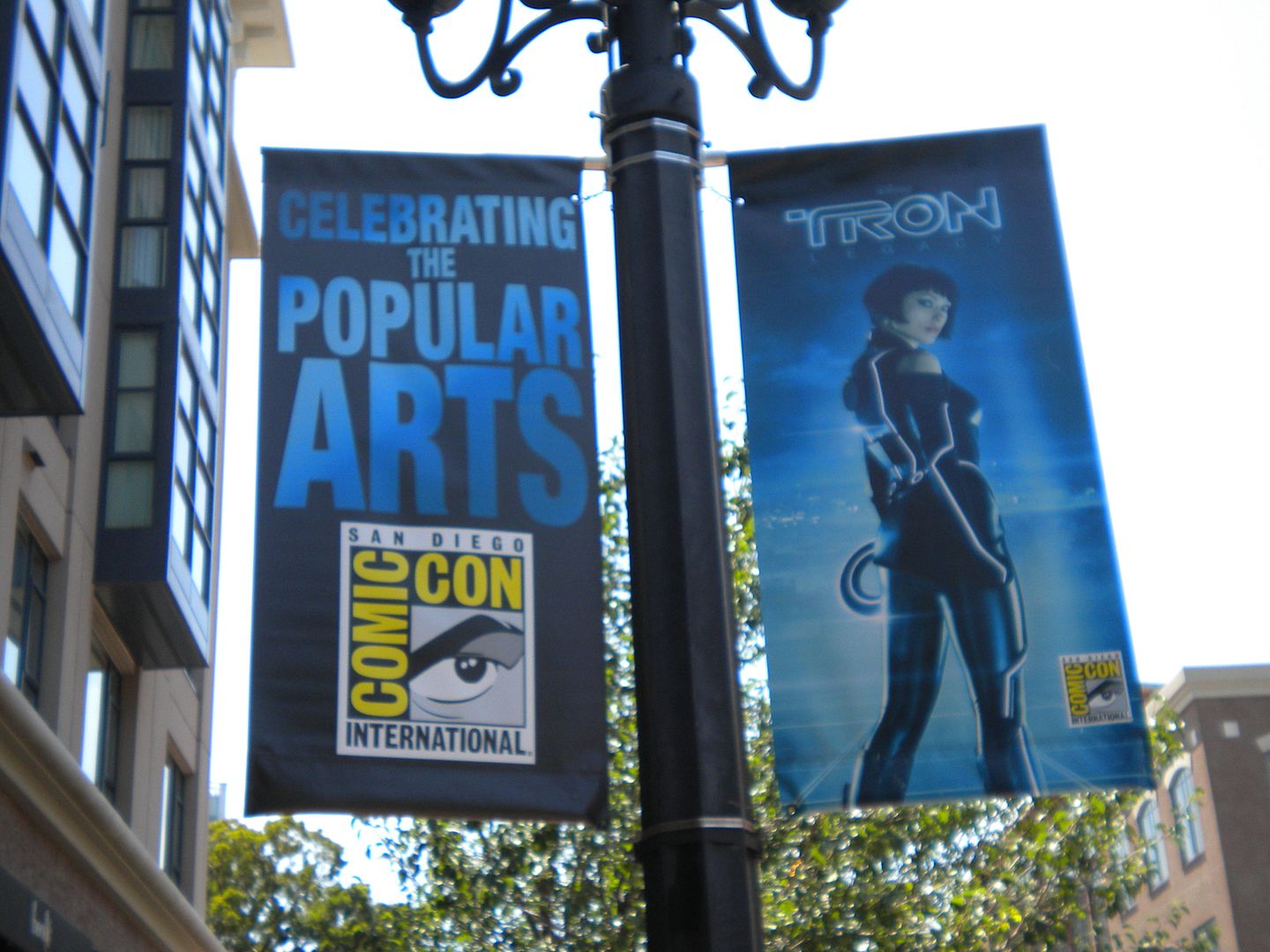
Day 3 was Star Wars Day at San Diego Comic-Con International and we have something shocking to report, ladies and gentlemen. We did not see a single light saber, not one! Since we almost incurred an unfortunate eye injury last year due to an overenthusiastic Jedi, this was most welcome relief. For ScriptPhD.com, today was all about science and technology. In a day that could not have been more tailor-made for our website, we enjoyed panels with the eminent sci-fi television writers of today discussing writing for genre TV (a must-read for any aspiring TV writers out there!), a visit from the greatest science fiction writer in the history of science fiction, Ray Bradbury, a preview of next season’s sci-fi show The Event, and a panel on how exactly shows like CSI “tech” out with gadgets galore. Oh, yes, did we mention we got to hang out privately with the MythBusters?? With the help of our intrepid reporter Bryy Miller, we bring you the most complete Comic-Con coverage on the web. Plus, our Costume of the Day, after the “continue reading” cut!
The Write Stuff: Creating Genre Television
LOST. CSI. V. Battlestar Galactica. It seems that sci-fi, tech, and geek-chic television is everywhere. Not only is it a staple of prime time (across basic and extended cable), it’s an increasingly popular genre for which good writers are constantly in demand. Since we are SCRIPTPhD.com, an opportunity to listen in as a panel of some of today’s hottest genre television writers gave away secrets of their craft and advice for aspiring writers was irresistible.
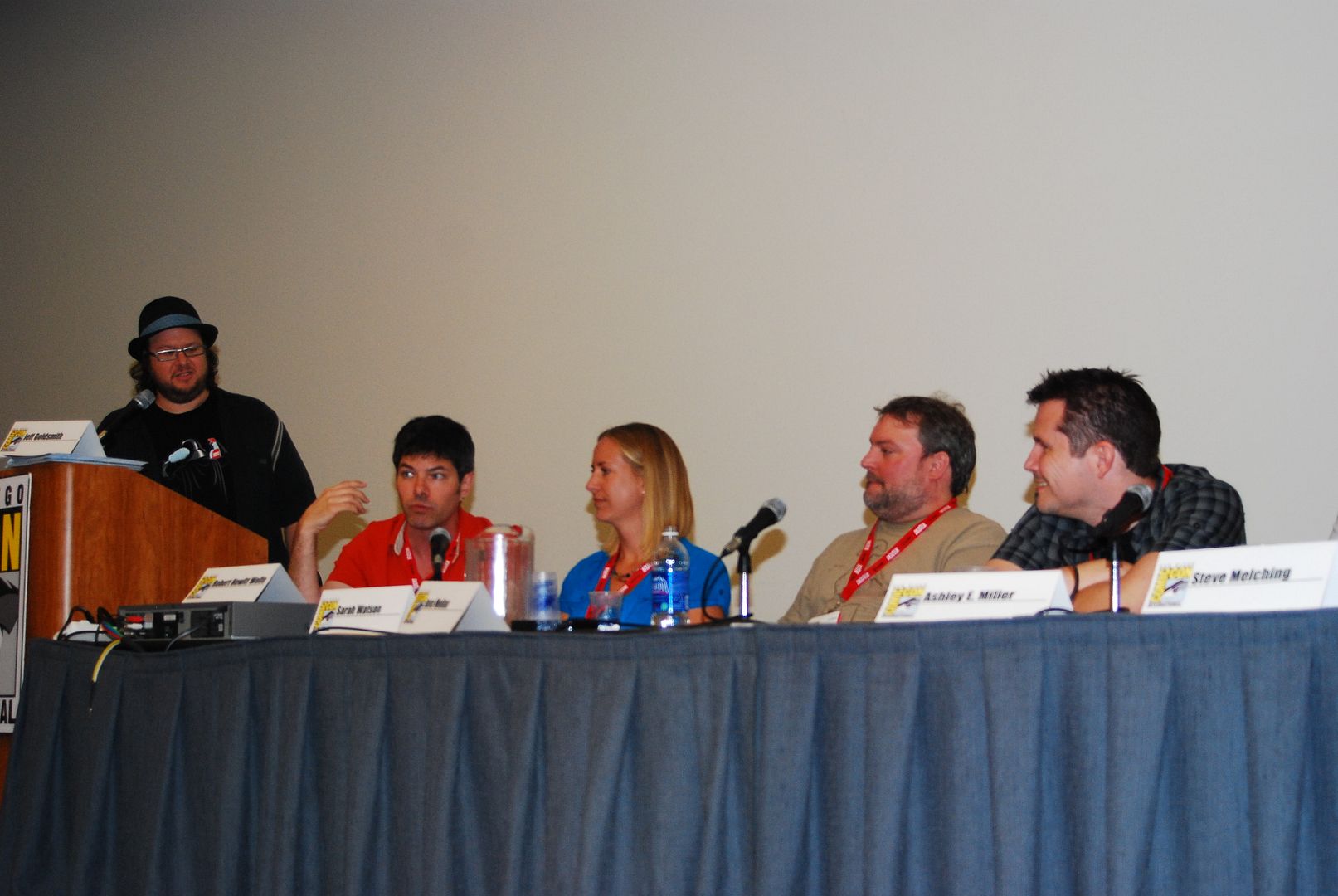

Since this panel consisted of so many writers, albeit a dream team thereof, there was only an allotted amount of time for three questions, each of which the panelists answered one by one down the line, and quite enthusiastically. The moderator, Jeff Goldsmith, who runs the industry rag Creative Screenwriting correctly pointed out that not only are they all working in TV, but if they weren’t on this panel, they’d be at Comic-Con anyway. He called them the “Algonquin geek table.” The first question was to ask each screenwriter what brilliant idea they had that would revolutionize a show they were working on at the time, but that couldn’t get past the network censors.
Mark Altman (Castle, Elvis Van Helsing) recalled creating a pilot called Elvis Van Helsing, but ABC went with The Middle Man instead. So he turned it into a graphic novel, and the rest was history. Charles Murray (V, Criminal Minds) actually recalled a terrific idea for an episode of Criminal Minds, where a serial killer would put a milk carton in someone’s fridge and the “Have You Seen This Person?” picture would be of the dead person. Clever, we thought! Steve Kriozere (NCIS, VIP) had the clever idea on VIP of casting Bruce Campbell to play Pamela Anderson’s uncle. The amazing and talented Jesse Alexander (Alias, LOST, Heroes) recalled a victory for geeks in the form of Heroes Season 1 in an episode entitled Days of Future Past where all the characters went into alternate future. He mentioned that it was so hard to approve and get on air, but the episode went on to win multiple awards. What didn’t make it? “Season 5.”
Steve Melching (Clone Wars, Transformers, The Batman) recalled writing for the animated series The Batman taking place in his first few years in Gotham City, and wanted (but failed) to approve a B story about a frat boy group dressing up in D-List costumes, committing fake crimes and then videotaping their subsequent ass kicking by Batman. We wonder why that didn’t get approved. Ashley E. Miller (Fringe, Terminator) wanted a Fringe follow up to the episode “Bishop Revival,” which had an immortal Nazi. He wanted a flashback episode to 1942, where we find out that Agent Phillip Broyles is 100 years old, and whacking Nazis. Jose Molina (Castle, Firefly) wanted a Firefly payoff episode with a 9-months-pregnant woman being evil, where the team kills her but they save the baby, and the episode would consist of three acts of “Three Men and a Baby.” Right. Sarah Watson (Middleman, Parenthood) recalled being hired to do a SyFy Channel movie of the week about an untapped volcano under Manhattan (seriously!), and she had grand plans for lava engulfing Statue of Liberty, taking over all of Manhattan island, but when the movie got produced the visual ended up being lava trickling out from under a garage. Robert Hewitt Wolfe (The Gates, Deep Space Nine) was writing for 4400 in its final season, and was obsessed with the idea of creating an aerosol promycin bomb over Seattle (hmmm, as a Seattleite, I booed this from the audience). The showrunners created a promycin bomb at the end. So the next time you think all TV writers are geniuses, just remember that for every great episode of your favorite show, there were many bad ideas tossed around in the writers’ room.
Next, Goldsmith asked the panel to recount (as diplomatically as possible) the stupidest network notes they’d ever encountered for a show script they worked on.
Mark Altman recalled working on a SyFy Channel movie where executives asked him to recap the whole plot at the beginning of the hour because of people tuning in from HBO. Charles Murray, while working on V, was told he couldn’t use the word lizard in an episode. How do you get past something like that, he was asked. “I left the show. That’s how you get past it.” Steve Kriozere revealed the #1 SyFy Channel rule of movies: don’t speak to the monster. Jesse Alexander, having worked on some of the greatest sci-fi hits ever, waxed more philosophical. Everyone has an opinion on these shows, but executives want the rules of the show’s world, they want everything spelled out clearly, a lot of exposition. They’re generally happier if the shows are procedurals, but sci-fi shows don’t have room for that—if all the secrets and exposition are revealed it drives people away from the content. Steve Melching pointed out that a lot of animated shows have hyper-sensors because they’re aimed at children. The dumbest note he ever received was that you can’t say “killer satellites.” Ashley E. Miller was reminded (we are shocked!) that you cannot have an 11 year old boy say douchenozzle on prime time TV. Jose Molina recalled an episode of Castle where a body is found in the teaser, the guys go through case, and find out that the victim was killed by a stiletto. Said the executives: “Does the killer have to kill with a shoe?” Sarah Watson revealed that the most annoying thing to writers on shows now is that they’re paid by sponsors, so writers have to put products into scenes strategically. Her worst example was an episode of a show with a surf competition…sponsored by Tampax. To make this work, they had to cover a poor actress’s entire surf bodysuit with Tampax logos. Robert Hewitt Wolfe was taken out to dinner by the main executives of a show he was working on and flat out asked to dumb down the series. Ahhh, the things you learn when the iron curtain goes down.
Finally, Goldsmith asked the panel to give advice to young TV writers (or aspiring writers) on how to best write for a budget, which is unfortunately what most young writers will face on television these days.
Without question, the panel answered unanimously that the secret in the writing is all. about. character. The best and cheapest special effects are two actors in a room with terrific conflict and terrific dialogue—that’s what’s compelling, that’s what’s intimate. Most physical action, they reminded us, is actually superfluous—only revert to it after all possible dialogue is tapped out. Ultimately, you must look at how what you cut (if you are forced to cut things) affects the character. If you put six people in a scene, make sure that all of them need to be in the scene, because it is extremely expensive to shoot. The writers lamented that networks sometimes have too much money, and a subsequent desire to compete with Transformers or Iron Man, which television can’t do. Writers must remember that character works for television, and you can have high-concept ideas for sci-fi. That’s why shows on cable, which are often budget-restricted, are so great. Sarah Watson reminded the audience that you can always make a show cheaper, and fantastic, with great writing and great dialogue. This is how Friday Night Lights, which shoots on a shoestring budget down in Texas, was able to survive for five seasons.
Mostly, in advice relevant to any writer reading this, they said not to repeat past mistakes.
The Event

This television show, premiering in the fall of 2010, might be the new LOST, or it might be the new FlashForward. I’m not sure yet. The Event, a show that is so steeped in mystery that even its title is nothing more than Something Happens, was a show—and will be a show—with as many problems as it has concepts. Fortunately, all of its flaws are structural.
The pilot is laid out as three separate stories (well, actually, four, but one is extremely short in comparison) over the course of three separate acts. We actually start the show in the middle of the story when our hero, Sean Walker (Jason Ritter), hijacks a plane in order to save it, and then flash back to eight days earlier, and then forward to seven days earlier, and then once more to the present. It gets even more confusing when President Eli Martinez (the incredibly suave Blair Underwood) gets his go at the story, and then his segment goes back an entire year. The other two stories comprise of the father of Sean’s girlfriend, whose house and family are assaulted by unknown forces, and Simon Lee (Ian Anthony Dale), the supposed second-in-command of a secret government base/prison that lies at the center of The Event. It’s a shame that Lee’s section is so short, as Dale is a fantastic actor even within the confines of such little material. But perhaps the best acting comes from ER/West Wing (and Northwestern University!) alumna, Laura Innes, who absolutely nails her cryptic sayings as Sofia, the leader of the base/prison/thing-to-be-revealed-later.
The show will need to cut out some of the flashes in order to survive past its initial thirteen episodes, but it is definitely a unique format that works for this type of story. The writing was high-quality and so was the dialogue; there were no qualms there. It also revealed quite a bit about the world that had been set up if you looked closely enough. Co-Producer Evan Katz made the promise that answers would actually come a lot faster than with other mystery longforms. This is welcome, especially since I am of the belief that mystery shows can maintain the mystery if they answer questions in the right or clever way. Sometimes, it is even essential to answer them if you want the show to progress to its next level of weirdness. Blair Underwood was then asked what it is like to be the first Cuban president, to which he replied that there would be no Salsa dancing.
Katz then ended the panel the only way it could have possibly ended:
“The Salsa is not The Event.”
Spotlight On: Ray Bradbury
He is brilliant. He is one of the foremost technology predictors since Leonardo DaVinci. He is irreverent, utterly aware of his importance, and quite simply, the greatest science fiction writer in the history of the genre. He none other than Ray Bradbury. Ray has been coming to Comic-Con since the very first year of its inception. A devoted comics and graphic novel buff, he loves interacting yearly with fans, and gracing them with his musings, knowledge and appreciation. We were honored and somewhat overwhelmed to be there in person for Ray’s 41st Comic-Con panel, on the heels of his 90th birthday. Because Bradbury’s words speak for themselves, we bring you the panel through his eyes.
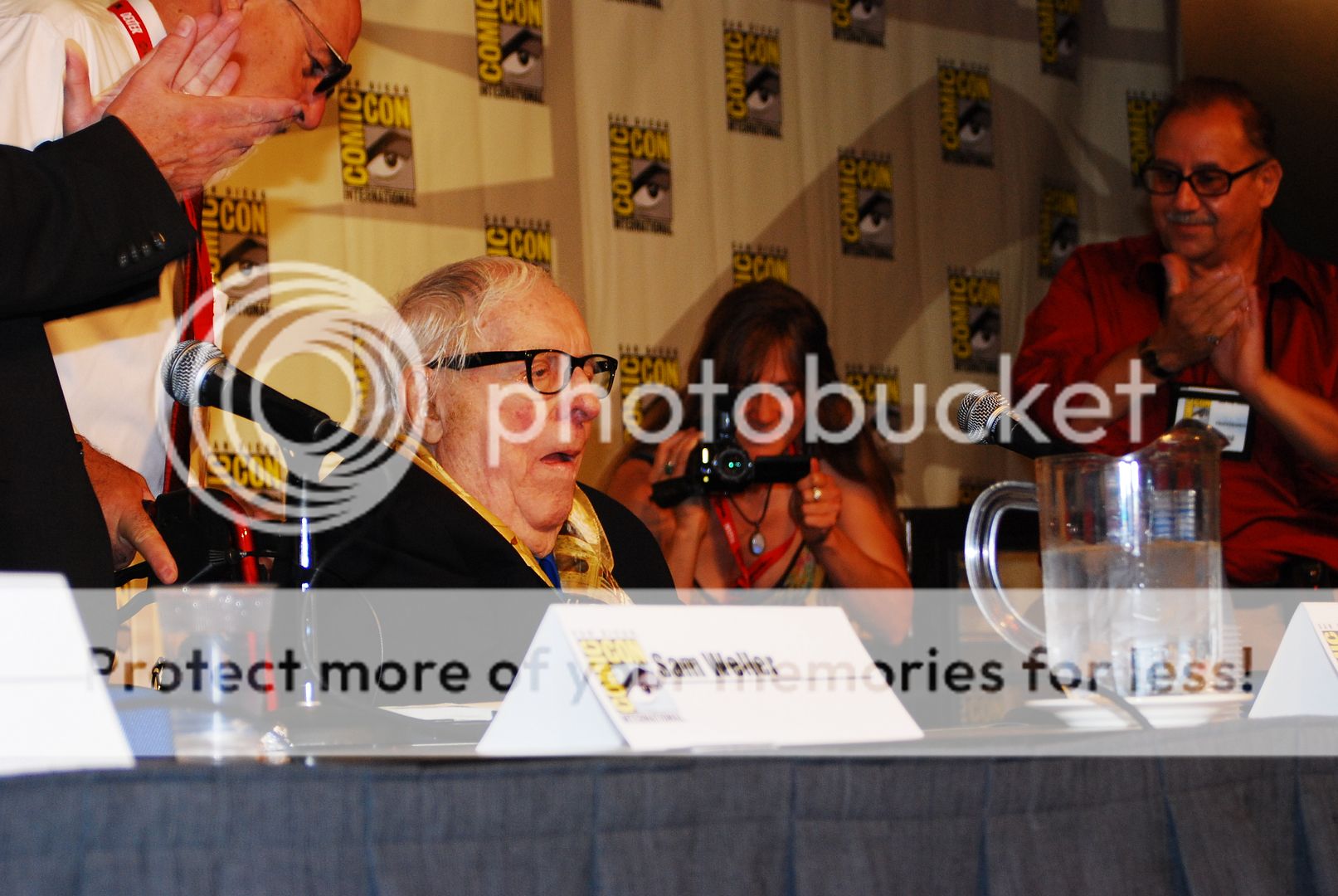
Bradbury, not shy about quips and bold statements, starts out his panel with a bang: “I want to make an announcement. Sam Weller and I are working on a new book together: Let’s Let The Cat out of the Bag.” In actuality, Weller and Bradbury released a brand new book of interviews (out June 29th) entitled Listen to the Echoes: The Ray Bradbury Interviews. Weller has spent over a decade with Bradbury, getting to know him, studying his works, and acted as his guide during the panel (Mr. Bradbury has become a bit hard of hearing). Bradbury is currently working on a new book of 20 short stories entitled “Juggernaut” to be published next Christmas.

On how it feels to be Ray Bradbury and if he ever marvels at himself, after a long, thoughtful pause, a hearty laugh and: “It feels mighty damn good.”
Fahrenheit 451 was among the most prescient sci-fi works of all time, predicting technology such as earbuds, flat screen televisions, school violence, and the rise of graphic novels. How did Bradbury predict all this stuff?
“The secret of life is being in love. By being in love, you predict yourself. Whatever you want is what you get. You don’t think about things; just do them. Don’t predict them—just make them.”
Of the technologies Bradbury predicted, he also warned about many, including rise of mass media. What tech would he like to see next?
Again, a thoughtful pause. “I’d like certain technologies to disappear. The internet is a great, big, stupid goddamn bore.” Keep in mind that when Bradbury was approached by an internet magnate to publish his works as e-books for the internet, he responded with: “Prick up your ears and go to hell!” The internet magnate? None other than the CEO of Yahoo.
Another strong, recurring theme of Bradbury’s panel was his love (adoration, really) of space exploration, most notably colonization of Mars and the Moon. Why? “Because we’re going to live forever. We should go back and build a base on the Moon, put a civilization on Mars. 500 years from now, we’ll go out into the Universe, and when we do that, we have a chance to live forever.”
Weller tried to get Bradbury to discuss the new book, once again evoking his crotchety sense of humour: “You can’t afford it. So get out of here and forget it.” In an extremely revealing, intimate moment, Weller pointed out that many Mars stories and works are inspired by and cut from Bradbury’s Martian Chronicles, none more similar than the Twilight Zone. Bradbury then revealed something that many of his fans probably don’t know. “Rod Sterling came to my house many years ago. He didn’t know anything about writing sci-fi. So I took him down to my basement and gave him copies of books written by Roald Dahl, John Collier, a number of other great sci-fi authors, and myself. Rod Sterling forgot that he read all these books, and when he wrote his programs, he copied some of his ideas from me, and we got into a big argument.” The two never reconciled.
As we’ve mentioned, Bradbury came to Comic-Con in its first year, where he said only 300 people came to first meeting, quite different from today, where 1,000 people were gathered in his room alone. Why does he come so often? “Because I’ve been collecting comic strips all my life. I have 30 years’ of Prince Valiant Sunday illustrations put away, all of Buck Rogers. My background in becoming a writer was falling in love with comic strips.” How did they influence his prose and narrative? “Comic strips are full of imagination and glorious adventures. My all-time favorite is Mutts. A year from now, there will be a graphic novel of “The Martian Chronicles” and “Something Wicked This Way Comes.”” Bradbury is, in fact, the world’s greatest (and possibly oldest) fanboy. He is famous for writing fan letters to writers and other figures that he admires. He sent books to John Huston, the famous screenwriter and filmmaker. He sent a hand-written letter to Edgar Rice Burroughs begging him to come to a meeting of Bradbury’s science fiction society club.
Another thing fans may not know is that Bradbury is considered the patron saint of the American library system. He has been very active in rescuing libraries that are under fire because of budgetary crises. He recounted the story of his love affair with the library. “When I left high school, I had no money to go to college. I decided to not worry about going to college. I thought: “I will educate myself.” So I walked down the street, I walked into a library for 3 days a week for 10 years. Most of you in the audience can’t afford to go to college. But if you want to educate yourself, you can afford to go to the library. When I was 28 years old, I graduated from the library.”
The concept of time travel is explored in the short story “A Sound of Thunder.” If Bradbury could time travel, he was asked to what moment it would be? “Every. Single. Moment. Every single moment of my life has been incredible. I’ve savored it. It’s beautiful, because I’ve remained a boy. The man you see here tonight is a 12 year old boy, and he’s having fun!” How does he stay connected to his inner child? “Don’t worry about the future, or the past, you just explode every day. If you’re dynamic, you don’t have to worry about what age you are.”
Indeed, childhood is a theme of many of his short stories. Why is this so important to Bradbury? “Because I grew up loving carnivals and circuses. That’s why I wrote those stories.”
When asked if he had any regrets in life, Bradbury evoked the biggest laugh of the day: “I regret that I didn’t have more time with Bo Derek.” What’s the Bo Derek story? She came up to him in Paris train station, and exclaimed “Mr. Bradbury, I love you!” To which he responded, “Who are you?” She replied, “My name is Bo Derek. Mr. Bradbury, will you travel on the train with me?” With a stoic face he recalled replying: “Yep, I will!” The rest was censored.
Other than Be Derek, what was his greatest love? Bradbury turned philosophical. “I am the world’s greatest lover. I love to write short stories. I write them. I love to write novels. I write them. I love to write poetry. I write it. I love to paint pictures. I paint them. I loved directing a film. So I directed it. Those are my greatest lovers. I have loved all these things I have told you about.”
What authors inspired Bradbury growing up? “Edgar Rice Burrows. And Edgar Allan Poe—scared the hell out of me.”
Another fact about Bradbury that many people may not know is his rather illuminating and successful career as a designer and architect. He was asked how he got involved with designing the San Diego city center Horton Plaza. ”I designed a lot of other places all over LA. 50 years ago, the people who were building the New World’s Fair asked me to redesign the United States Pavilion. I helped build Epcot down in Florida. Because of those works, the people of San Diego came and asked for input in building The Horton Plaza at the center of San Diego.”
Aldous Huxley famously said of Bradbury, “You know what you are sir? You are a poet.” When asked who the poets are that have influenced his writing, Bradbury immediately responded: “Shakespeare and Alexander Pope.”
What are the things that keep Bradbury motivated now? “I have more work to do.”
On how his writing has changed over time: “It’s gotten more brilliant.”
As such a fan of Mars, Bradbury was asked how he feels about the ongoing Martian probes, and the real science evidence they have brought back to Earth. “I’m glad we are doing that [research], but we should be doing more. We should be going there in person. Not with a lander, but with a real rocket ship and landing on Mars.” In a rather endearing moment, Weller revealed that Bradbury has never driven an automobile. But he was invited to the Jet Propulsion Laboratory in Pasadena, where scientists asked him if he’d like to drive the Mars Rover over Mars. So he hasn’t driven on the 405 freeway, but he has driven across Mars! The scientists even gave him a Martian drivers license.
Any futuristic technologies for cities that Bradbury would like to see? “Monorails all over LA and California. Get rid of the goddamn freeways!” As a Los Angeles resident, hear, hear, Mr. Bradbury!
What was the intended audience of Fahrenheit 451 and how does he feel about its rise to prominence as a true modern American classic? “I am not a science fiction writer. All my books are fantasy. But the one book that is pure science fiction is Fahrenheit 451. So I’m glad that I wrote it. I’m glad that you all feel that way about it too.”
Does Bradbury have a favorite work? “All of my books are my favorites. All of my books are my children. I love all my children.”
How does Bradbury feel about digital books? With a cranky grunt: “I’ve already told you that. I don’t like them. I think of iPads and Kindles as books with a computer screen. Real books smell, real books have memories.” We here at ScriptPhD.com would like to give that statement a heartfelt “AMEN!”
Finally, Bradbury, on turning 90 in a few weeks. How does it feel? “It’s been 90 goddamned incredible years!” To which the audience responded by singing him “Happy Birthday.” A surreal, incredible and special moment.
Teching Out on TV

This panel started out with an inundating montage of clips from tech-chic procedurals CSI and NCIS that involved technology of all sorts. It was part awesome and part utterly corny, as words to the song that was spliced in occasionally would find themselves on to the screen. I was afraid that this foreshadowed the panel being just a huge PR stroke for both shows, but I was later proven wrong. Despite the moderator speaking in a loud, fast, incoherent style of mumbling, the rest of the speakers (Anthony Zuicker, creator of CSI; Pauley Perette, CSI; Barrett Foa, NCIS: Los Angeles; Kirsten Vangsness, Criminal Minds; and Rich Catalani, producer of CSI) were very articulate about all aspects of technology on their shows. They strove to make it less a panel about technology on CSI and NCIS and more about technology and how it relates to CSI and NCIS.
The presentation started out with questions about how everyone got involved in their work, and more specifically, how they got involved in technology, or if they even were. Perette studied forensics in college, talking about how, back in her early years, nobody knew a thing about it. She related a story that the first time that her computer was hacked into, she tried to tell the police, but ended up having to explain to them what an IP Address was. Then, after shows such as CSI and Law & Order made technology and forensics mainstream, everyone was a part of a club that they felt they cultivated. “We all became semi-experts,” she said. “It’s been an incredible decade of change. What we’re showing on our show is the grand upmovement”. Vangsness was a tad in the opposite direction: she took teaching jobs in order to support herself, and one of those jobs was teaching PowerPoint to third graders. She now has images of third graders hacking into government installations to post spam of kittens.
Foa stopped the discussion at one point to explain to the audience that his show, unlike the original CSI, does not stare at a green screen when looking at his computer tomfoolery. It is all real. Which complicated matters greatly when Perette’s character met Foa’s in a crossover between their two shows. She had to literally teach him on set how to react to a green screen as oppose to a real image. Foa also related how the super-tech that we often think of as fictional and made up is actually real. The CSI writers have access to China Lake, a military outpost where they test experimental technology. Scary, huh?
But sometimes technology cannot save you, and honest-to-God legwork must be put into use. For one CSI episode involving a stampede of ants, they actually had to hire an Ant Wrangler and clean up all the creepy crawlies using a vacuum. CGI was expected to just look too ridiculous. Then, in a devilish sort of irony, the projector broke, so the panel was cut short and went straight to questions. Perette was met with a young woman who was going to major in Cellular Biology in college because of Perette’s performance on CSI.
Thus, the cycle continues.
MythBusters: Panel + Press Room Coverage
How popular are Discovery Channel’s MythBusters? Very. Each year, the group of geeky demolition rock stars, who prove and disprove popular science myths through the scientific method, represent one of the fan favorite panels at Comic-Con. This year was no different. Press pass notwithstanding, we barely squeezed into a sardine-tight hall full of science fans awaiting their heroes’ arrival. Take a look at the picture below:

As if the presence of television’s most explosive group wasn’t enough, the audience was tantalized two-fold before the panel. First, a montage video introducing the Busters had us cracking up with its over-the-top… what else?… explosions!

Then, a special guest, Geoff The Robot from The Late Show with Craig Ferguson, stepped out to proclaim his nerdy love of all things MythBusters.

Finally, to ear-deafening applause, Chris Hardwick of one of our favorite blogs The Nerdist (follow him on Twitter) introduced the MythBusters, who announced that they’ve signed up for 7 more years of glorious science. This is a very special Comic-Con for them. It’s the first time all five have come as a group, and it is gorgeous geek diva Kari Byron’s first Con.
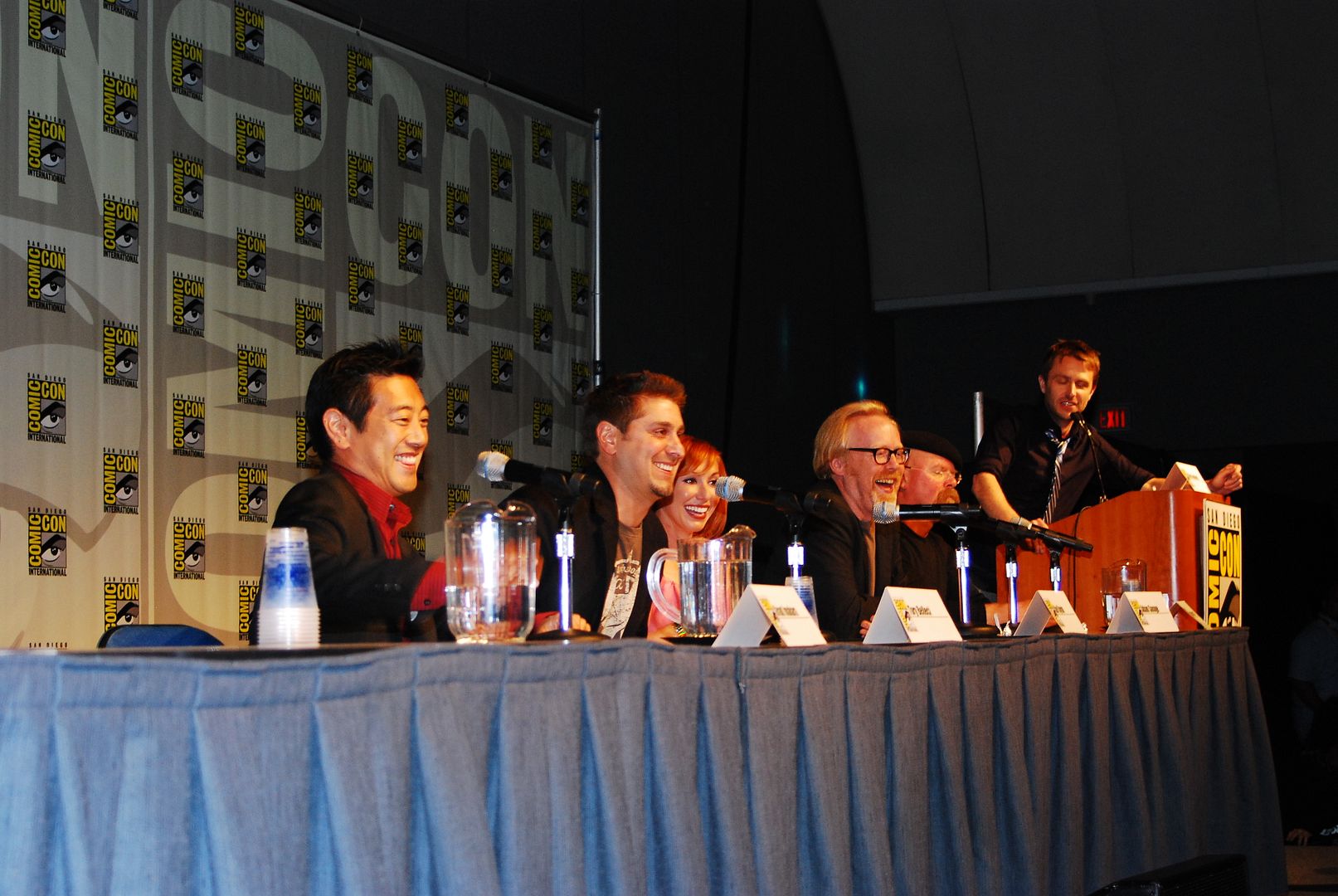
The first thing the MythBusters wanted their fans to know is just how very real they are. Although they feel like royalty at the Con, when they go back home to San Francisco, MythBusters is far from glamorous. Inside their workshop, which is a workshop and not a studio, they are doing all of the stunts and building themselves. They get dirty, they get bruised, and they do all of the experimenting. Says Adam Savage: “If you see it, we built it.” Although Savage has started getting more involved behind-the-scenes, he explained that the team is so knowledgeable about how to build things, that it’s faster and more efficient for them to do the building than to leave it to someone else. Tory Bellici mused that it would be nice to have stunt doubles sometimes, to which Kari Byron quipped: “They’re not stunts when you fall off.” Did we mention that we love Kari? Jamie Hyneman, who initially signed up for MythBusters because of the allure of getting to try new things, is still having a hard time acknowledging being on TV. When asked what famous people he’d met because of MythBusters, he couldn’t recall one. “President Obama?” nudged Byron. “Oh. Yeah,” replied Hyneman hysterically. Not so for Grant Imahara, possibly the most famous robotics guy in the world. “Craig Ferguson called me the Keith Richards of robotics,” said Grant. “I’m not sure how to take that.”
The audience was treated to a highlight reel of the upcoming season, which promises to have the best, and most extreme, experiments yet. The team revealed some of the secrets. Adam Savage revealed that a scene of a Porsche flipping backwards violently was done to bust an old 1980s myth that classic sports cars are more aerodynamic going backwards than forwards. In an utterly bad-ass bit of reconstruction, the body of a Porsche chassis was cut off, flipped backwards on the car, then raced at 100 miles per hour. Any more questions, kids? A scene showing Kari puking violently (she joked that it was in her contract to have to throw up every year) was explained as an episode testing whether people really do get cold feet when they have to do something scary. For the team, scary meant picking, then eating, two of the most disgusting selections from a table of delicacies consisting of spiders, cockroaches, chicken feet and more. And where does the team get their constant supply of ideas? “Surfing the internet really works!” joked Grant Imahara.
As to whether the team is cognizant of how much they advance science and critical thinking, and actively try to build experiments around didactic aims, the answer is… NO! Jamie remarked that as a whole, the MythBusters are a remarkably curious group. They are curious about stuff, they try to figure it out, and do so in a methodical and logical way. But they never set out to do science. Which, honestly, in the opinion of this website, is why their science is so great.
At this point, the team shared fun and hilarious inside stories from their Comic-Con experience and tidbits from back home in San Francisco. Adam recalls being shocked at two geeks that came up to him at an autograph table with their baby, wearing a onesie that said “Proof that nerds have sex.” Despite his uncomfortable laughter, the duo then asked him to sign their baby! Another fan went up to Jamie and remarked: “I’ve been watching your shows since I was a little girl and now I’m a PhD!” We’re pretty sure Jamie was kidding, but Adam still poked fun back at him. “You’re old!”
Just in time for next week’s Discovery Channel Shark Week, Adam recalled a fan coming up to him a few months back with what the fan was convinced was a brilliant suggestion: “Dude, you know what you should totally do? You should totally prove that, like, punching sharks will make them go away! Seriously, dude, it would be awesome! You’d just punch them.” A brief pause from Adam. “8 months later, there we were, knee deep in sharks, punching them in the face…”
Kari revealed that she filmed the show up to her 10th month of pregnancy. She pointed out that it’s a myth that pregnancy only lasts 9 months. (BUSTED!) She was worried that her baby would never come out. Replied Grant: “With all those explosions and gunshots outside, I wouldn’t come out either!”
Finally, to a fan that asked whether the team is ever scared of an experiment as too dangerous, Jamie reminded him that danger is a relative term. Nothing the MythBusters do is any less dangerous than driving down a freeway at 70 miles an hour. The trick is to good engineering and survive by doing a good job.
The new season of MythBusters premieres in the fall. Find coverage of their Comic-Con panel and clips from the new season on the MythBusters website.

We got to spend even more time hanging out with the MythBusters (and Geoff) backstage in the press area to get even more scoop about the show. We all wondered about the research process that the team undergoes. First and foremost, Adam proclaimed that they “don’t ever get things tested because they’re too dangerous.” There’s nothing the team is afraid of, and no length of time is too long to wait for a payoff. The research can take anywhere from 2 weeks to 2 years. The team searched 19 months for a lead layer thin enough to do an experiment properly. By contrast, the poppy seed drug testing experiment took two hours. They ate poppy seed muffins at 9 AM, and tested positive for heroin at 11 AM (well into the next day).
When asked about their terrific rapport, the team reiterated that they very much enjoy each other’s company and socialize quite well. All of the process, from picking to carrying out experiments, is totally collaborative. Secondly, the team shares a bond because they know each other quite well. “It’s not like we’re a science show boy band,” joked Adam. Most of them have known each other and worked together well before MythBusters began. Unlike other shows, MythBusters goes on for most of the year (46-47 weeks) because the building portions of the segments are so time-consuming. The most important thing to Jamie is a strong sense of respect that trickles down all the way to the show’s loyal crew of 23 people.
For the future of the show, Jamie revealed an interest in looking at the dichotomy of destructive things that do good work as well, steam being high on his list. The team never gets inspiration from movie trailers or clips if there’s no story there and they’re not worthy of a myth.
Adam revealed the interesting fact that somebody actually bought the Corvette which had been fouled by a decomposing pig to prove that a decomposing body can destroy the inside of the car. Adam now associates the smell of cleaner with that episode, which makes him sick to this day. Was that the team’s least favorite experiment, wondered ScriptPhD.com? Grant picked the ear wax candle experiment, jokingly calling it the “seasickness experiment.” Tory picked the chili pepper cure experiment. (“Burns on the way in, burns on the way out!”), while Kari picked the water torture episode. The most destructive experiment to this day, much to the chagrin of OSHA and safety regulation organizations of San Francisco, was the Civil War rocket, tested with a wax core. The team thought they had a proper bunker in the shop, but unfortunately ended up setting fire to their ceiling!
On any potential Discovery Channel crossover shows, Adam revealed that he’d like to go out into the wild with Bear Grylls (and so would I!) while Kari revealed that she would not like to do a dirty job.
And for the highlight of my personal day…

Last, but not least, is our official Day 3 Costume of the Day. We chose this warrior for a simple reason. He braved the chilly convention center without a shirt, yet with a completely covered head. Now if that isn’t upside-down thinking, we don’t know what is!

Incidentally, you can find much more photographic coverage of Comic-Con on our Facebook fan page. Become a fan, because this week, we will be announcing Comic-Con swag giveaways that only Facebook fans are eligible for.
~*ScriptPhD*~
*****************
ScriptPhD.com covers science and technology in entertainment, media and advertising. Hire our consulting company for creative content development.
Subscribe to free email notifications of new posts on our home page.
]]>
